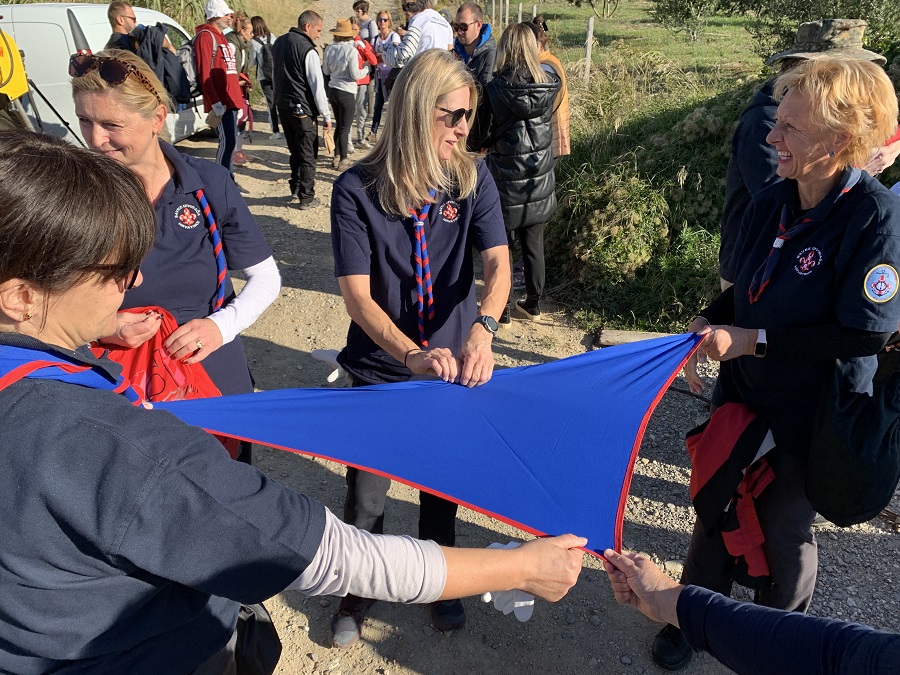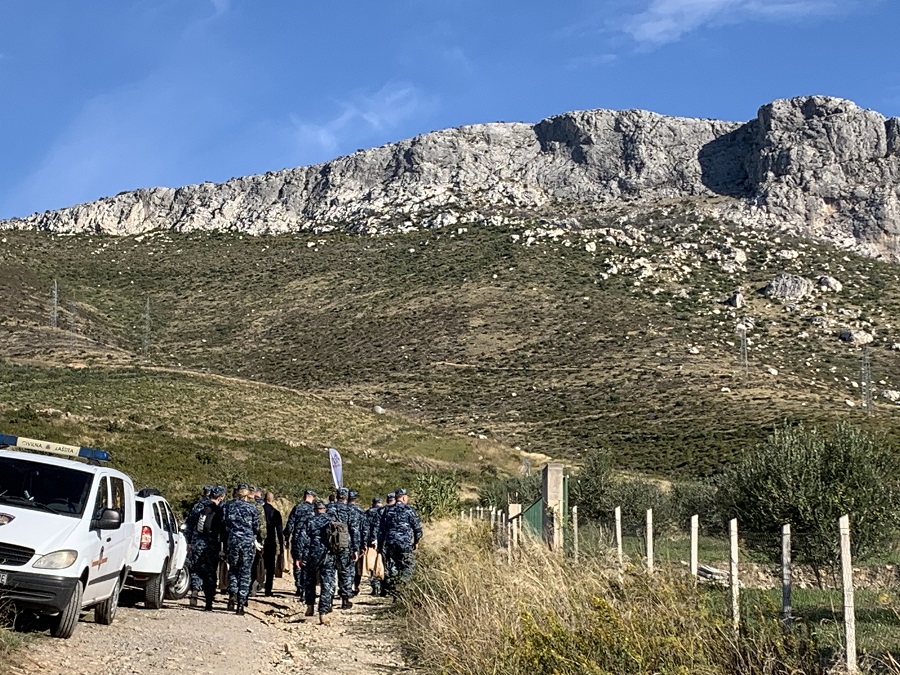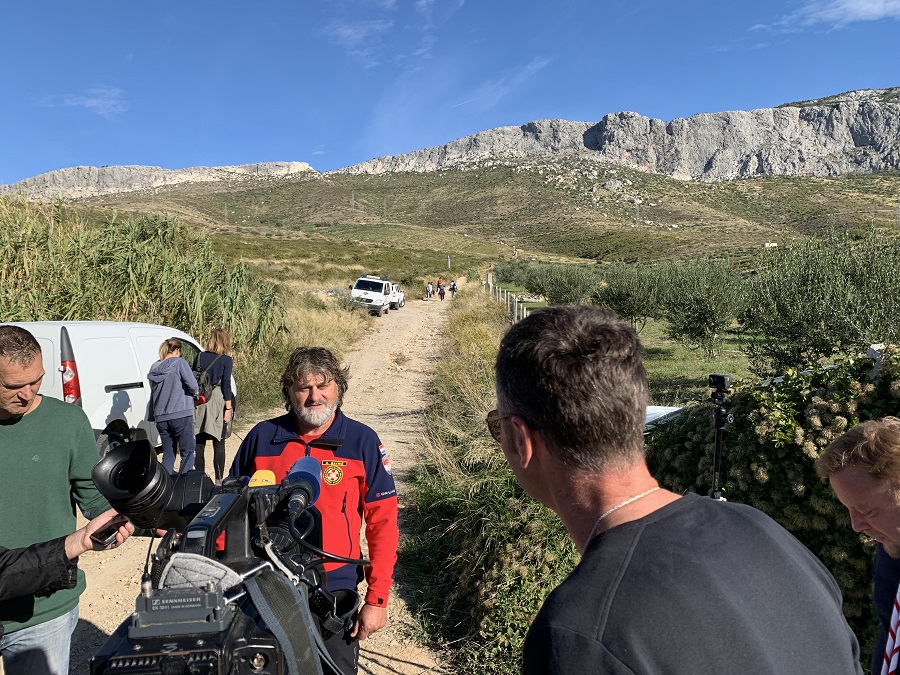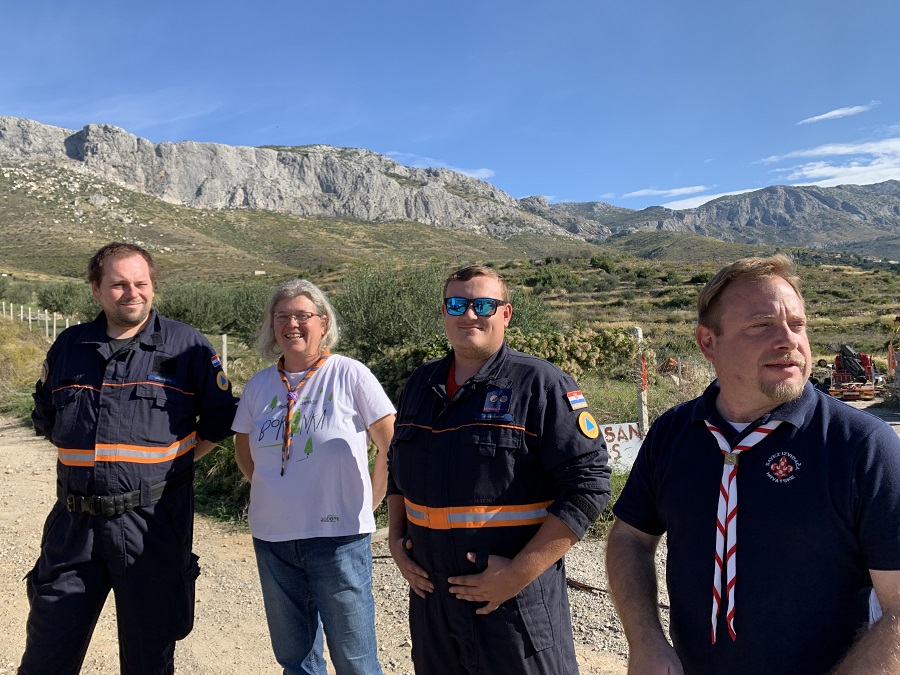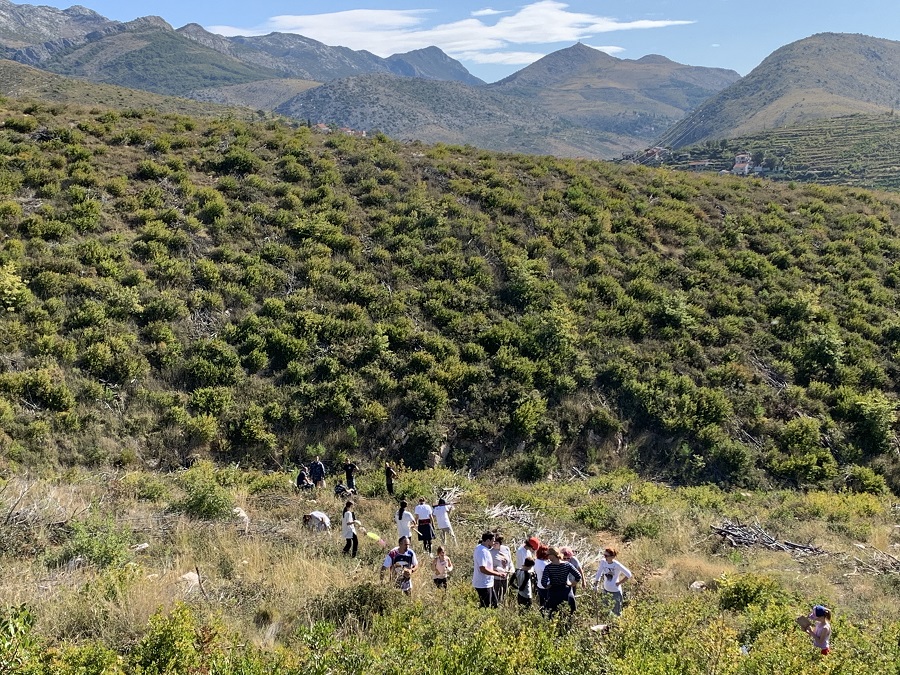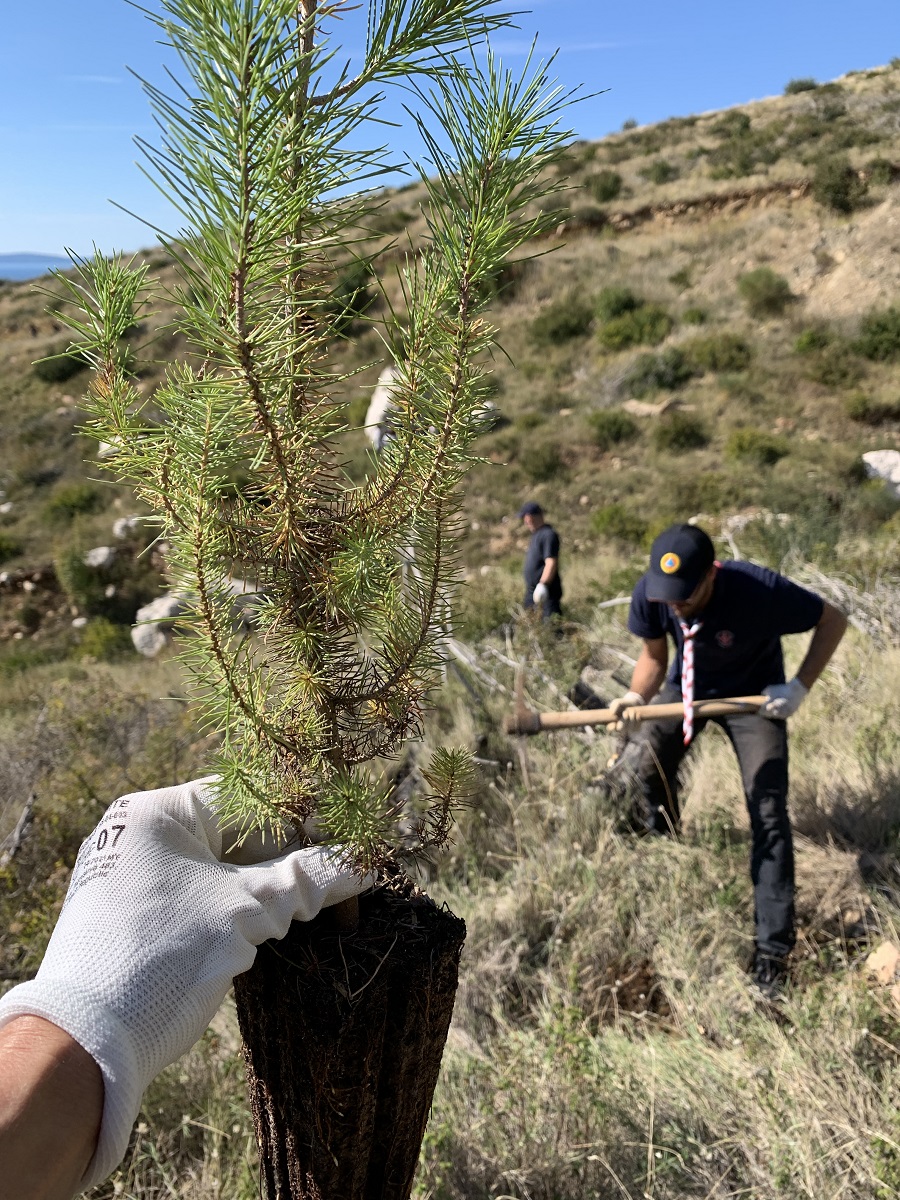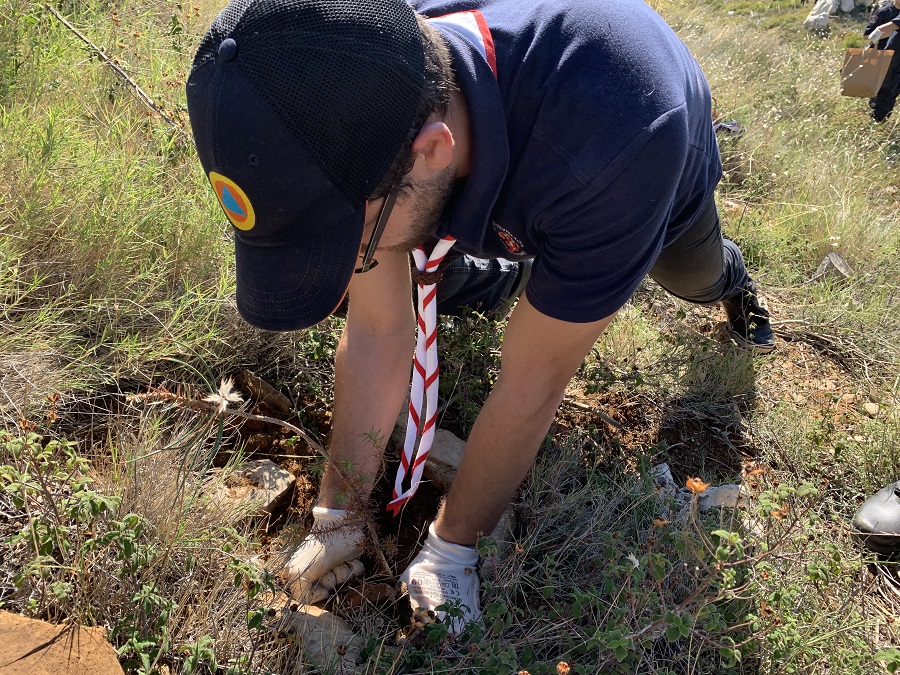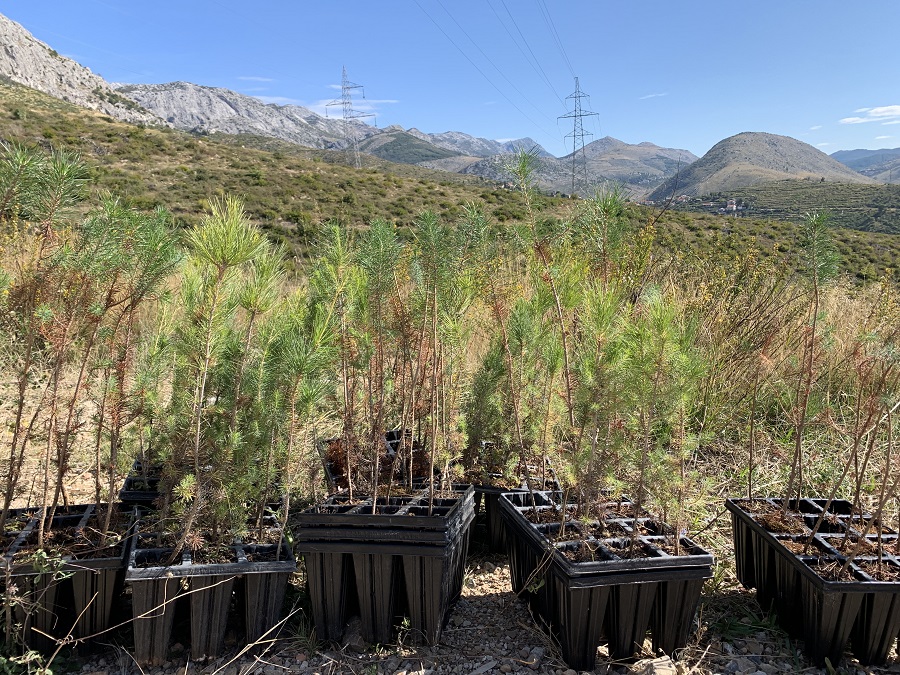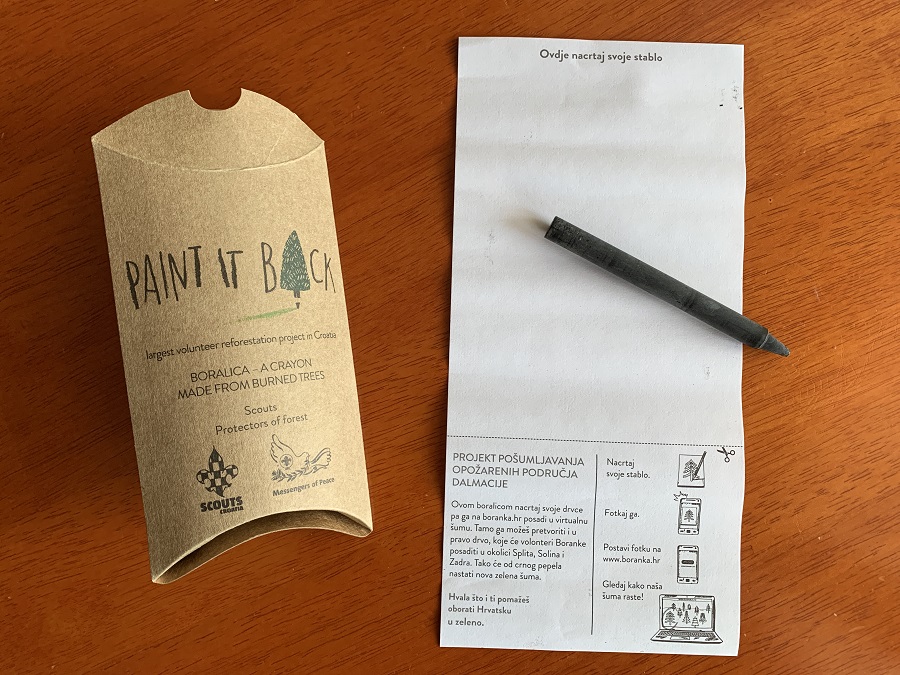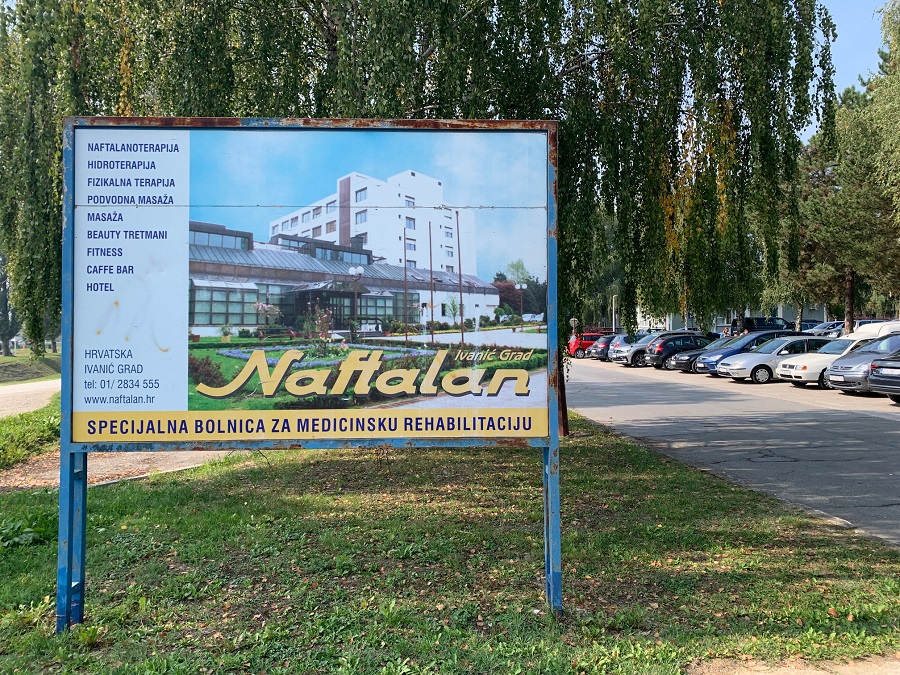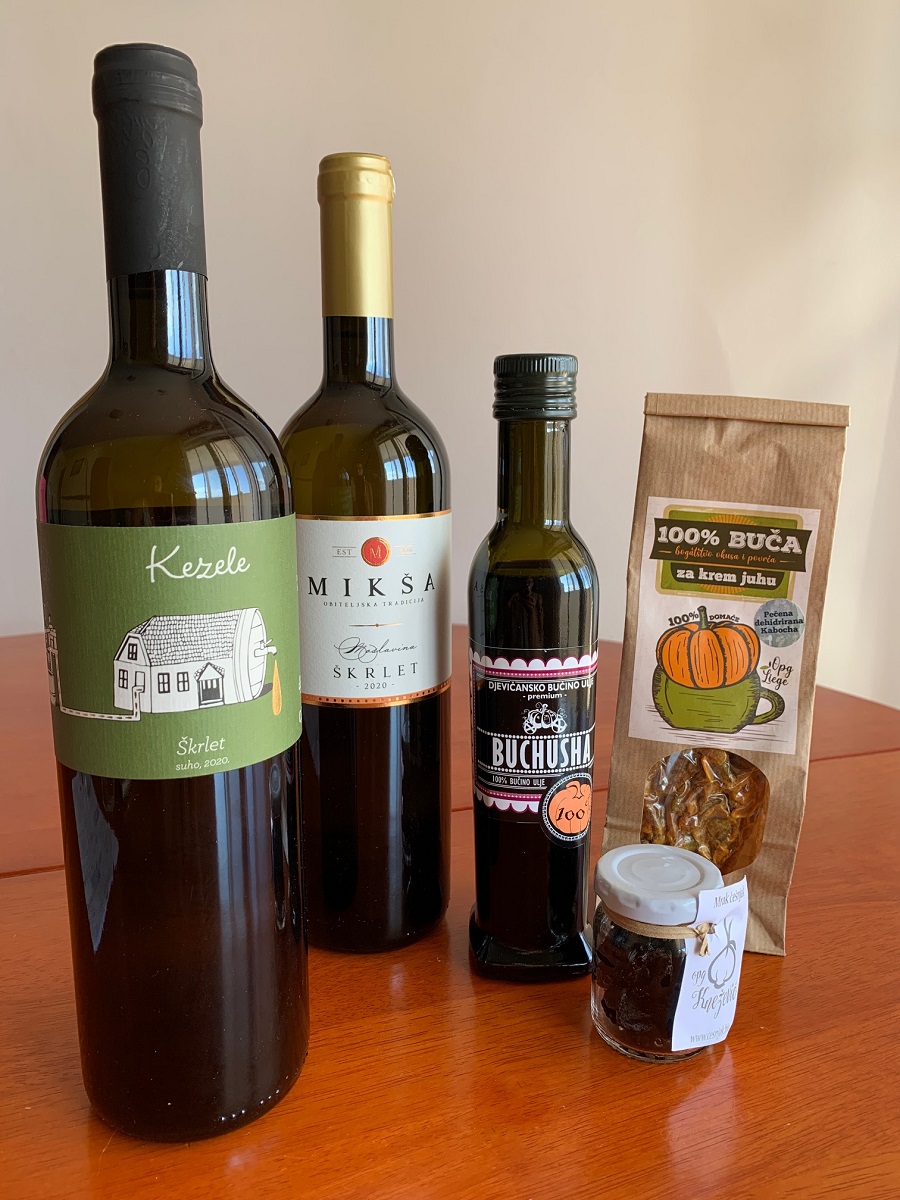Croatia Through the Eyes of a Digital Nomad: Boranka Plants Virtual Trees in Real Life
October 21, 2021 - The Boranka reforestation campaign encourages children to color trees and volunteers to plant them, it’s part of an ongoing effort to bring the green back to the burnt area of Dalmatia.
Ever since my Girl Scout days, the Scouts hold a special place in my heart. Americans love the cookies (I sold plenty of ‘em), but I’m talking about the program. I filled my sash with badges earned for all sorts of activities, including a badge my mother made for our troop when we came up with a new sewing project. When I heard about the Boranka campaign, led by the Scout Association of Croatia, I was keen to volunteer for the reforestation effort on the mountain. Plus, it’s a great day outside in nature.
(Scout leaders making tight neckerchiefs. This part of the scout uniform represents a scout’s promise to uphold Scout beliefs and it also has practical functions, such as protecting the wearer’s neck and being made into a slink or bandage for first aid.)
So many volunteers
This was my second year as a volunteer, planting seedlings on Mosor Mountain. Unlike my first experience with other digital nomads and expats, I was side by side with Croatians from a long list of organizations that support the campaign, including Croatian Forests, Croatian Mountain Rescue Service, Scouts of Brodosplit, Croatia Red Cross, Croatia Navy, Croatia Civil Protection, and of course, the Scout Association of Croatia which leads the physical effort as well as the marketing campaign. It was an impressive bunch up there!
(The Croatian Navy is the first group to head up Mosor, where they will disperse into different sections on the mountain.)
It’s amazing how much interest there is—Croatian schools, mountaineers, armed services units, veterans, and the president, along with NGOs, ambassadors, and expats from around the world, have been on the mountain doing the same job as me and getting their hands dirty.
(Darko Gavrić, head of the Croatian Mountain Rescue Service (HGSS) in Split told reporters, “We’re all working together on this.”)
Split scouts
A free bus took us volunteers from Split and when I arrived in the area known as Korešnica, I was given a pair of gloves, water, a sandwich, fruit, and a cool goody bag. Nearby, I watched some scout leaders roll up a neckerchief with precision; this is part of the scout uniform. Three women held the corners of a scarf and pulled tight as a fourth began rolling one edge. The leader rolled and pulled, rolled and pulled, and finally handed the finished piece to her colleague who placed it around her neck. I noticed how skilled the women were at this and when I mentioned that it was funny to watch them work so seriously and still keep up their casual chatting, they laughed and were like, “yeah, no big deal.”
(Two members of the Croatia Civil Protection from Zagreb with Sanja Matešić, President of Sea Scouts Brodosplit, and Dan Špicer, Business Director of the Scout Association of Croatia and Boranka campaign coordinator—all on active duty for a great day of volunteering.)
Sea Scouts Brodosplit
The Scouts of Brodosplit—aka Sea Scouts Brodosplit—were heading up the weekend’s volunteer effort, a job that rotates between six different local Split units each weekend. Scout Mihi, the “Chief of Staff,” and his wife Sanja, “the boss” (the president), were there with nearly 40 of their members, including a big group of teens and others they call Friends of Scouts. For the latter, this is “a way of life and a way of helping,” Sanja said. She loves running camps with the members, especially the Cubs, all over Croatia.
(Even with a pickaxe, digging holes in Mosor’s rugged mountain terrain can be tough with all the stone.)
Planting seedlings
When it was time to get to work, we formed into little teams—one person dug holes and another placed seedlings in the ground. Others went back and forth from the supply truck to pick up more trees. Weather can be harsh in this landscape with intense summer heat and year-round Bura wind. To help these little guys succeed, you have to pat down the dirt firmly around them and surround each one with small rocks to hold the dirt in place and keep the moisture in the ground.
(Volunteers from all over the world and different backgrounds meet on the mountain for a productive and fun day.)
Roughly 90,000 trees have been replanted in four years, a mix of local pine and oak varieties. These native species somehow grow in rock, not like our trees in the U.S. that grow in dirt. Apparently, there’s enough water below the surface of this karst landscape to keep them alive.
(Everybody works together, digging and planting, with lots of friendly banter included.)
Boranka campaign
My burning question was, what does the word Boranka mean? Dan Špicer, business director of the Scout Association of Croatia and the Boranka campaign coordinator, filled me in. Bor translates as pine and bojanka as coloring book. “It’s a word game,” he said, a clever marketing concept based on bringing the program to the people and “coloring your tree.”
Dan’s team came up with an idea to make crayons from the burnt pine trees. When you use one to draw and see the color on your fingers and the paper, a connection is created—to the fire, to nature, to the campaign. Over 150,000 ash crayons have been made so far and over 10,000 have been distributed to schools.
(Tips for helping the small seedlings grow successfully include pushing down the dirt firmly then surrounding them with stones, which are protective measures against harsh growing conditions.)
Kits instruct kids to color their own forest and name their tree. For every tree drawn and uploaded to a database, a tree is planted by Boranka volunteers. At one point the system overloaded due to the overwhelming response.
There was another hurdle early on to get the crayons made. “Where do you burn two trucks full of burnt trees?” Dan found a factory willing to help and they devised a special formula. The machines jammed at first, they weren’t used to ash, but the team figured it out.
(Seedlings ready to be picked up by volunteers and planted.)
Future campaign
With millions of trees lost in the devastating 2017 fire around Split, the Boranka effort isn’t going away any time soon. In November, a new campaign will start — Co2mpensating by Planting. This CO2 program appeals to organizations’ desire to offset their carbon footprint. Companies will buy trees and scouts and volunteers will plant them, it’s a direct one-to-one transaction. The European parliament and the American embassy are already onboard with support.
When asked about coordinating such a big undertaking, with so many moving parts and pieces and different organizations, Dan told me, “the campaign came easy, it came out of a need, to save something, not just to plant trees.” That’s what he cares about and that’s what I love about Scouts, their heart and passion.
(Campaign kits called “Draw Your Tree” include an ash crayon, drawing paper, and instructions on how to draw your tree and plant it in the virtual forest (in the database) where it will be turned into real tree planted by Boranka volunteers.)
Digital nomads and others can still volunteer for this upcoming weekend, October 23 and 24. Find more information on the Boranka Facebook page.
Story and photographs ©2021, Cyndie Burkhardt. https://photo-diaries.com
Learn more at TCN’s Digital Nomads channel.
Croatia Through the Eyes of a Digital Nomad: Fall Means its Bučijada Time!
October 4, 2021 - Americans say pumpkin, Croatians say bundeva. Americans eat pumpkin pie, Croatians eat bučnica. How a simple pumpkin festival reminded me to embrace cultural traditions and remember that finding what’s new and different is why we travel.
At a recent meetup for digital nomads in Zagreb, one of my colleagues mentioned the annual bučijada (pumpkin festival) starting the following day in Ivanić Grad, a town roughly 45 minutes outside of the capital. I squealed with delight. I love eating pumpkin in various forms and the pie (specifically, my mother’s creation) is one of my all-time favorite foods. Hers is the gold standard of pies everywhere, with its tasty filling, creamy texture, and moist crust. I look forward to this time of year for all kinds of pumpkin goodness, the only season when it’s available.

(The annual bučijada in Ivanić Grad, outside of Zagreb, is one of the town’s largest fall festivals.)
How fun would it be to sample Croatia’s versions of this fall favorite and pick up some new treats too?! What do they have here that’s different from what we have at home? As it turns out, quite a lot.
Consuming pumpkin
My stomach led as I walked off the train in Ivanić Grad the next morning. I met the wonderful Aleksandra, and asked where I could find pumpkin pie. “We don’t make that here,” she said. What about pumpkin bread, surely this bread-forward culture loads it into the bakeries? No again. Had I tasted bučnica? The savory pastry is a pumpkin strudel, popular in and around Zagreb, and made with pumpkin, fresh cheese, cream, and eggs wrapped in a thin dough. My first-ever serving there at the festival was pretty darn good.

(The sweetest pumpkin at the festival was working the crowd near his family’s product table.)
Croatians love all sorts of fresh vegetables, why don’t they cook and eat more pumpkin? Because the squash is considered animal feed. So sad…
Fresh pumpkin seeds and pumpkin beer were abundant however, and pumpkin seed oil—bučino ulje—was the prize at the festival. An entire street was dedicated to OPG’s selling this nutty-tasting oil and other pumpkin products.
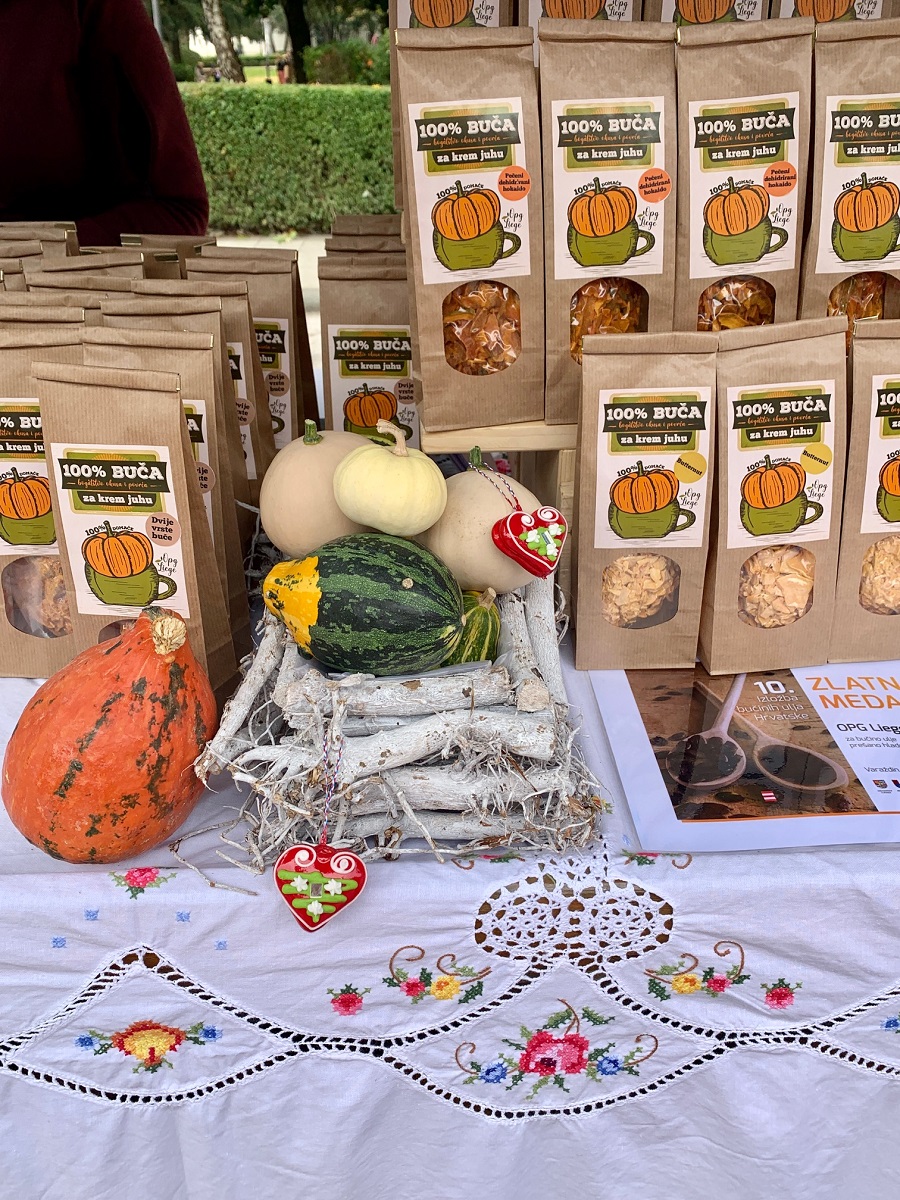
(A dried soup mix, made with 100% pumpkin, is a unique product.)
Pumpkin seed oil
Apparently, bučino ulje is a prestigious business, I noticed that several bottles displayed “winner” stickers. I knew why as soon as the oil hit my tongue—I was blown away by the flavor. I’ve had the store-bought oil and I will never do that again, there’s absolutely no comparison to Cro’s homemade product.
I was instructed on proper usage—don’t cook with the oil; only use it raw; cover food such as leafy greens and bean salad; drizzle it on strudel and vanilla ice cream; add to soups and stews for nutty sweetness. I’m pretty sure I’ll be sprinkling it on everything.
My disappointment over the pie was replaced with glee over the oil.
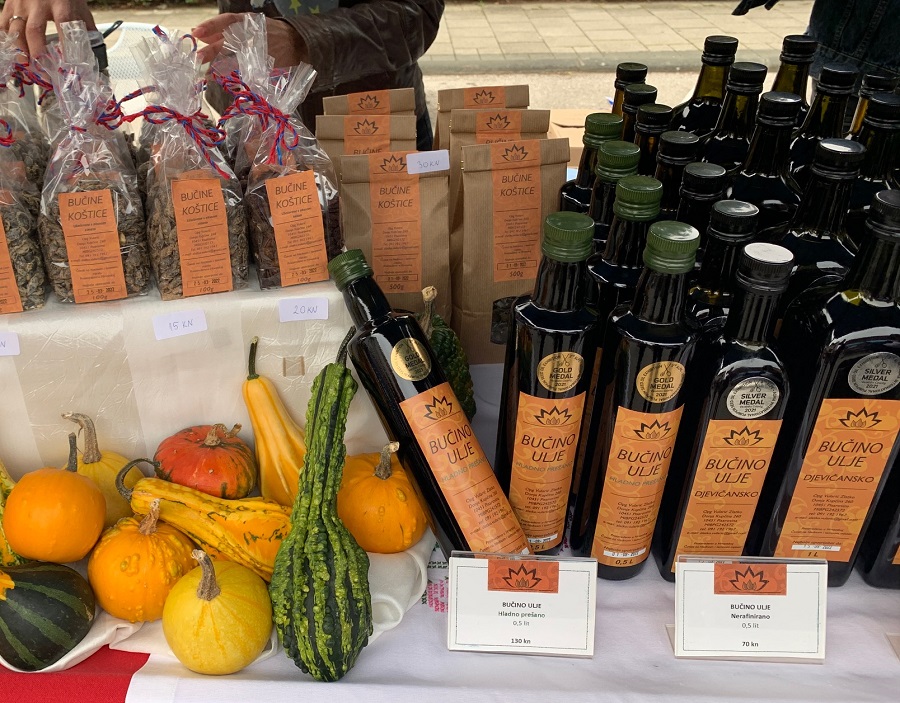
(Award-winning pumpkin oil, along with seeds coated in chocolate and other toppings, are frequently displayed on vendor tables.)
Eliminates wrinkles
Beyond trail mix and culinary applications, pumpkin seeds have serious medicinal credentials. They’re a rich source of vitamin E, zinc, omega 3- and 6- fatty acids, and antioxidants. In this regard, pumpkin seed oil is on par with Croatia’s other superfood—olive oil. It can improve heart health by lowering cholesterol and reducing high blood pressure. For us ladies, it’s an ingredient in skincare products that help hydrate the skin and eliminate the appearance of wrinkles. That right there is enough for me to gulp it.

(Not far from the festival, INA’s oil drills can be seen around town.)
Black gold
I thought I’d seen what the town had to offer when things went in a different direction. Ana Gašparović, president of the Association of Heritage Friends and a local tour guide, educated me on Ivanić Grad’s “black gold.” It’s a designation given to the town’s three prominent native oils—pumpkin, petroleum, and Naftalan.
(The Naftalan Special Hospital for Medical Rehabilitation was built to treat skin disorders, specifically due to the discovery of Naftalan oil.)
Black oil began bubbling up from the ground in 1855, when it was pulled by hand. One hundred years later, after World War II, Germans led the first industrial production and oil drills can be seen around town. The headquarters of the oil and gas utility INA is located a few blocks from the festival, along with several other company buildings. Ivanić attracted the nickname “Little Kuwait” for its generous crude supply. Unfortunately, today it’s drying up and production will soon be shutting down.
Slightly further away is Naftalan Special Hospital for Medical Rehabilitation. The facility is dedicated to the treatment of inflammatory skin disorders, such as psoriasis, and features creams and bath oils made from the medical Naftalan oil. Ivanić discovered its natural resource of Naftalan in the 1980s, which is rare. Azerbaijan is the only other place on the planet where the oil is found.
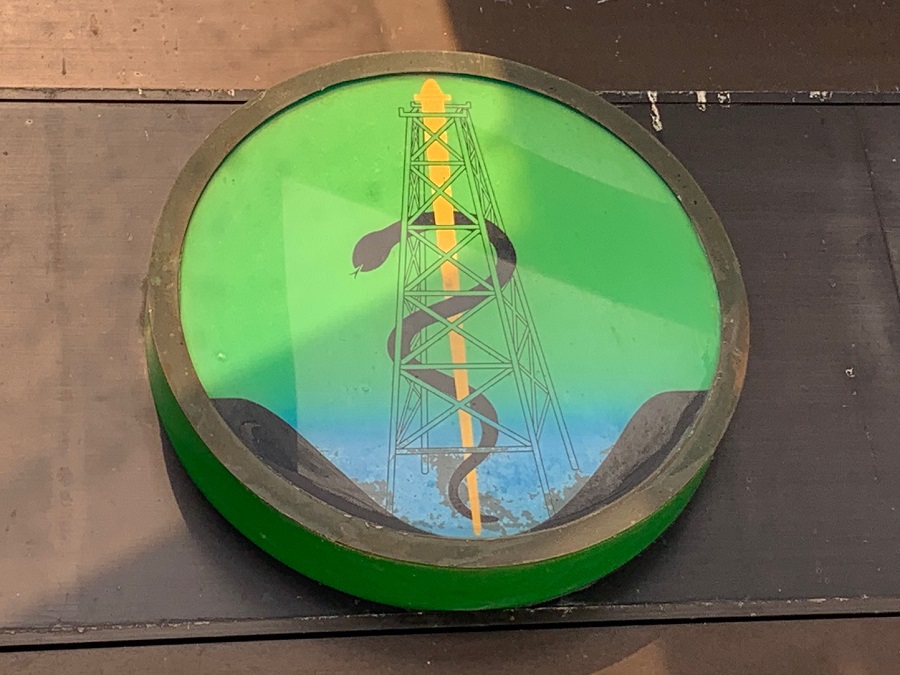
(The integration of the medical and crude industries is represented in a graphic above the entrance to the Naftalan hospital. A snake and staff, symbolizing medicine, is combined with an oil rig.)
Yellow gold
Aleksandra joked with me that Škrlet is Ivanić’s “yellow gold,” a grape varietal that’s indigenous to the Moslavina region. Eight vineyards produce wine from the slopes of the Moslavačka gora Mountain. Janko Kezele, president of Škrlet Moslavina Association and one of the eight family producers, said, “We are proud to produce the wine as we nurture our tradition and identity of our region and our homeland.” Doing my homework for this story, I found it light, fruity, and rather likeable.
(Several items made it home in the author’s backpack: two Škrlet wines (by Kezele and Mikša); 100% virgin pumpkin oil by Bachusha; dried soup mix by OPG Liege; black garlic by OPG Knežević.)
A rural festival
The festival was spread out with multiple locations of vendors, activities, displays, a music stage, and food concessions, and it was packed with visitors. Ivana Alilović, Director of the Zagreb County Tourist Board, said, “We’re happy to have 200+ rural exhibitors participate in this year’s festival, especially during these times with covid.” It’s Ivanić’s biggest pumpkin festival yet and it’s got a lot to offer.
On the train
Riding the train from Ivanić back to Zagreb, I reflected on how a pumpkin festival broadened my perspective. My American brain recalled memories of pie, warm apple cider, and picking pumpkins from a patch. My Croatian experience was a cultural enlightenment that included bučnica, bučino ulje, Škrlet, and a cool history lesson on the town’s industry, plus I met some nice local people.
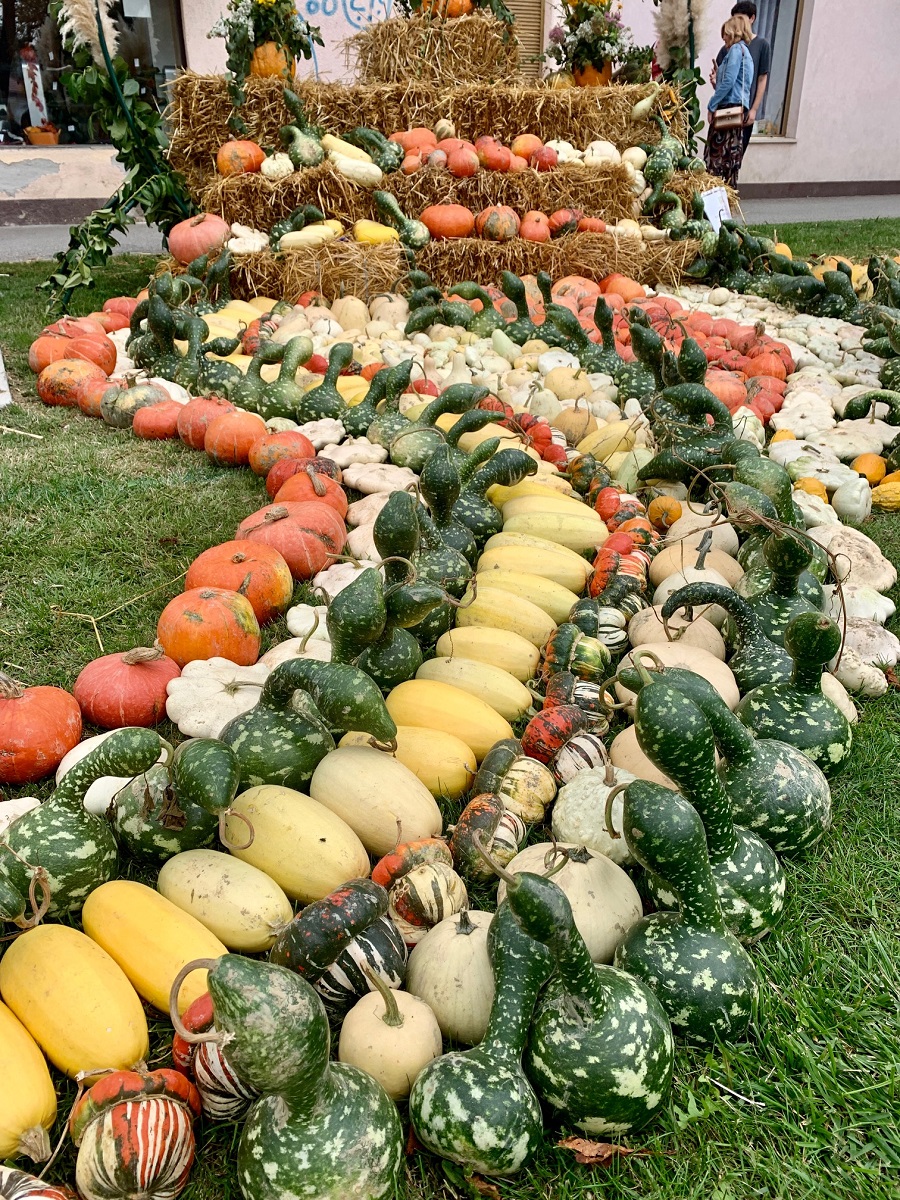
(It takes all shapes and sizes of gourds to make a colorful pumpkin patch.)
Story and photographs ©2021, Cyndie Burkhardt. https://photo-diaries.com
Learn more at TCN’s Digital Nomads channel.
Expats in Croatia/Pandemic Edition: Clare Brown from UK in Split (VIDEO)
February 18, 2021 - The global pandemic rages on and we’re still locked down with restrictions and social isolation. Some people are surviving and others are thriving. What’s their story? Episode #4 with… Clare Brown from the UK.
It’s almost one year since the World Health Organization declared covid-19 a global pandemic on March 11, 2020. Nobody expected what came next and certainly nobody expected things to last this long. But here we are, wondering when it will be over and hoping the vaccine will restore some sense of normalcy.
In the meantime, how are people filling their days? When it’s all said and done, how do they want to remember this time looking back? In this new series we’ll hear from all sorts of people in Croatia about their pandemic experience and their predictions for the future.
Episode #4 with… Clare Brown from the UK.
Clare Brown is not your typical law librarian. This proper English girl from the UK has taken Croatia by storm in the most beautiful and adventurous way. Initially visiting the country on holiday, several years ago, she fell in love with the region. Over the years she’s traveled throughout Croatia and the neighboring countries and has lived in different parts. Then, on a random night out, she looked across the room and saw a tall, handsome stranger. While most people lamented the pandemic, it was a side note to her budding romance. She speaks Croatian, makes rakija, cooks food from the family garden, loves a good coffee on the beach, and knows “a man” for everything. Croatian lifestyle resonates with her and she fully embraces it. The icing on the cake? Last year she married the handsome, tall guy! And now she’s a mom—to Bunny, an adorable little guy who hops around the floor and nibbles on dandelion greens. This expat is living the dream.
Story and photographs ©2021, Cyndie Burkhardt. https://photo-diaries.com
For more of Cyndie's experiences, check out her Croatia Through the Eyes of a Digital Nomad column.
Are you an expat in Croatia who would like to share your experiences during the pandemic in Cyndie's video series? If yes, please contact her on This email address is being protected from spambots. You need JavaScript enabled to view it.
We are also keen to interview any digital nomads who have successfully applied for the new visa, after the first success in Istria - Meet Melissa Paul, Owner of Croatia's First Digital Nomad Visa. Please contact us on This email address is being protected from spambots. You need JavaScript enabled to view it. Subject Nomad Visa.
Expats in Croatia/Pandemic Edition: Michael Freer, from UK in Split (VIDEO)
February 10, 2021 - The global pandemic rages on and we’re still locked down with restrictions and social isolation. Some people are surviving and others are thriving. What’s their story? Episode #3 with… Michael Freer from the UK.
It’s almost one year since the World Health Organization declared covid-19 a global pandemic on March 11, 2020. Nobody expected what came next and certainly nobody expected things to last this long. But here we are, wondering when it will be over and hoping the vaccine will restore some sense of normalcy.
In the meantime, how are people filling their days? When it’s all said and done, how do they want to remember this time looking back? In this new series we’ll hear from all sorts of people in Croatia about their pandemic experience and their predictions for the future.
Episode #3 with… Michael Freer from the UK.
Since arriving in Croatia nearly 6 years ago, Michael Freer has become somewhat of a local celebrity on the Split scene. For a guy who’s lived in multiple countries around the world—Spain, Argentina, and India for six months or more, and Cambodia for two years—he’s a “regular” around here. A little background… in Cambodia he worked for a school on curriculum development and he managed volunteers. He also had a factory gig implementing social accountability standards. Here in Split he runs his own company supporting early stage social enterprises and dedicates one day a week to working for a nonprofit, supporting foreign entrepreneurs for an EU project. Outside of all this, or perhaps because of it, he’s constantly networking, meeting new people, and getting his hands into all sorts of innovative projects. Commendable stuff, but what made the biggest impression on this girl? It was this, “oh yeah, I swim all year long, I go in the water every week.” Anyone who can jump in the Adriatic in these winter temperatures is celebrity-worthy in my book. And one more “plus” on my checklist, he learned how to make goat cheese during lockdown. Yum!
Story and photographs ©2021, Cyndie Burkhardt. https://photo-diaries.com
For more of Cyndie's experiences, check out her Croatia Through the Eyes of a Digital Nomad column.
Are you an expat in Croatia who would like to share your experiences during the pandemic in Cyndie's video series? If yes, please contact her on This email address is being protected from spambots. You need JavaScript enabled to view it.
We are also keen to interview any digital nomads who have successfully applied for the new visa, after the first success in Istria - Meet Melissa Paul, Owner of Croatia's First Digital Nomad Visa. Please contact us on This email address is being protected from spambots. You need JavaScript enabled to view it. Subject Nomad Visa.
Expats in Croatia/Pandemic Edition: Janette Buba from France in Split (VIDEO)
February 4, 2021 - The global pandemic rages on and we’re still locked down with restrictions and social isolation. Some people are surviving and others are thriving. What’s their story? Episode #2 with… Janette Buba from France.
It’s almost one year since the World Health Organization declared covid-19 a global pandemic on March 11, 2020. Nobody expected what came next and certainly nobody expected things to last this long. But here we are, wondering when it will be over and hoping the vaccine will restore some sense of normalcy.
In the meantime, how are people filling their days? When it’s all said and done, how do they want to remember this time looking back? In this new series we’ll hear from all sorts of people in Croatia about their pandemic experience and their predictions for the future.
Episode #2 with… Janette Buba from France.
Something I’ve noticed about people who have roots everywhere is that they tend to have heart—for life, people, and community. Janette Buba is one such soul. She was born in the Philippines, where her family originates, raised in Texas (USA), and has been living in France with her Czech husband Ervin. After falling in love with Croatia during a sailing visit, the couple decided to stay for a while. It was a perfect place to escape France’s hard lockdown and severe covid-19 restrictions.Janette is an early retiree; her previous professional life includes marketing management with Johnson & Johnson. Now she considers herself a professional “volunteer,” assisting in various community outreach programs and helping where needed. She met a special VIP during a reforestation project with the Croatian Scouts Association (you have to watch the video to find out who) and she’s a regular at the No Kill Animal Centralis shelter. It seems that having a passion for people, building networks, and kindness are pretty great retirement skills.
Story and photographs ©2021, Cyndie Burkhardt. https://photo-diaries.com
For more of Cyndie's experiences, check out her Croatia Through the Eyes of a Digital Nomad column.
Are you an expat in Croatia who would like to share your experiences during the pandemic in Cyndie's video series? If yes, please contact her on This email address is being protected from spambots. You need JavaScript enabled to view it.
We are also keen to interview any digital nomads who have successfully applied for the new visa, after the first success in Istria - Meet Melissa Paul, Owner of Croatia's First Digital Nomad Visa. Please contact us on This email address is being protected from spambots. You need JavaScript enabled to view it. Subject Nomad Visa.
Expats in Croatia/Pandemic Edition: Mahesh Herath from Sri Lanka in Split (VIDEO)
January 28, 2021 - The global pandemic rages on and we’re still locked down with restrictions and social isolation. Some people are surviving and others are thriving. What’s their story? Episode #1 with… Mahesh Herath from Sri Lanka.
It’s almost one year since the World Health Organization declared covid-19 a global pandemic on March 11, 2020. Nobody expected what came next and certainly nobody expected things to last this long. But here we are, wondering when it will be over and hoping the vaccine will restore some sense of normalcy.
In the meantime, how are people filling their days? When it’s all said and done, how do they want to remember this time looking back? In this new series we’ll hear from all sorts of people in Croatia about their pandemic experience and their predictions for the future.
Episode #1 with… Mahesh Herath, from Sri Lanka.
Mahesh is the owner of Antaari Ceylon Ayurveda Spa, located in Split’s Old Town. The spa was all set to make its opening debut last summer when pandemic restrictions forced it to close. But wait, why a Sri Lankan spa in Croatia? A bit of background…
Sri Lanka developed its own Ayurvedic system of traditional medicine based on a series of prescriptions handed down from generation to generation over 3,000 years. The ancient kings, who were also renowned physicians, sustained its survival and longevity. A well-known Sri Lankan saying comes from this legacy: "If you cannot be a king, become a healer." Mahesh became an entrepreneur, in the service of wellness, personal care, and hospitality. He was looking for a spa location when he happened to visit Istria. He quickly loved the people and the country and thought “why not here?”
Of the pandemic, Mahesh talks about positive mindset, being still, consciousness, health, and having a strong mind. Find spa information here: https://www.antaari.com/
Story and photographs ©2021, Cyndie Burkhardt. https://photo-diaries.com
For more of Cyndie's experiences, check out her Croatia Through the Eyes of a Digital Nomad column.
Are you an expat in Croatia who would like to share your experiences during the pandemic in Cyndie's video series? If yes, please contact her on This email address is being protected from spambots. You need JavaScript enabled to view it.
We are also keen to interview any digital nomads who have successfully applied for the new visa, after the first success in Istria - Meet Melissa Paul, Owner of Croatia's First Digital Nomad Visa. Please contact us on This email address is being protected from spambots. You need JavaScript enabled to view it. Subject Nomad Visa.
Croatia Through the Eyes of a Digital Nomad: Dalmatia’s Underground Fungi is Croatia’s Black Gold
December 28, 2020 - Cyndie Burkhardt continues her nomad lifestyle with her experiences in Croatia - this week with a little truffle hunting in Dalmatia.
The area surrounding Split is joining the exclusive and rarified world of wild truffle hunting, where these underground mushrooms are highly prized delicacies and adorable dogs track them down in secret locations.
One fine day I sat in a cozy hilltop restaurant in Motovun sipping Croatian red wine and gazing at both the picturesque view out across the countryside and the eyes of my handsome boyfriend across the table. We were exploring Istria and I was about to have the most anticipated meal of our trip. The entire place had a gentle whiff of truffles and it filled my nose. The waiter placed two bowls of pasta in front of us and started shaving truffles on top. He asked if I wanted more. I smiled and said “yes!” and he proceeded to cover my dish. I think I melted before I even took a bite.
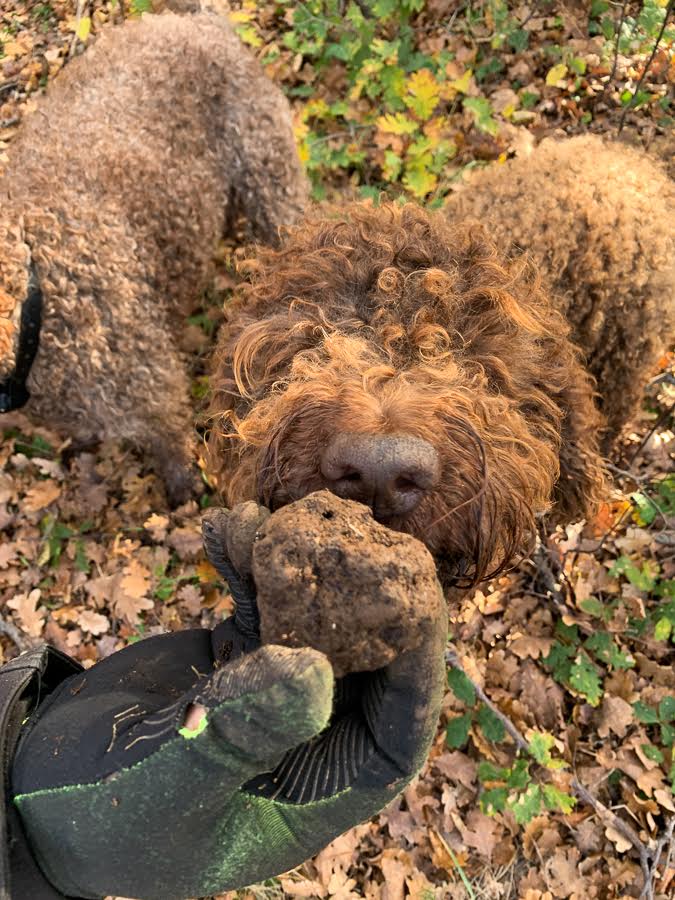
(Dogs experience the world through scent. The key to training them to find truffles is scent and positive rewards—they smell a truffle, they get a treat.)
That was years ago and I’ve eaten truffle pasta only one other time—until now, that is—but I’ve never forgotten the experience. The area surrounding Split is joining Istria and Zagreb in the truffle economy, as recently reported here. Learning that I could go on a real hunt with dogs, and eat truffles, I jumped at the chance.
Secret location
Ivana Najev met me near Mall of Split and blindfolded me before we drove to meet her father Tonci and the dogs at a secret location. It’s well known that truffles are highly coveted for elite dining tables and they rank among the rarest foods in the world with some of the highest prices. Given the stakes, I was only told that we were going to Mosor Mountain. The intrigue was killing me, but it was certain to be an adventure and I acquiesced.

(Dalmatia’s soil is predominantly black, which produces black truffles like this black winter Tuber Melanosporum.)
Truffle dogs
Once the car stopped and I got out and saw the dogs, they were irresistible. Aldi is seven years old and a seasoned professional. Indi is one and a half years old and is still full of puppy energy. Both are medium sized Lagotto Romagnolos with golden brown curly coats, and they’re absolutely adorable. Their fur reminded me of my grandmother’s hair, God rest her soul. I liked them immediately. The dogs darted around the forest bursting with excitement before getting to work. I laughed out loud watching them run about, their faces and tails full of expression.
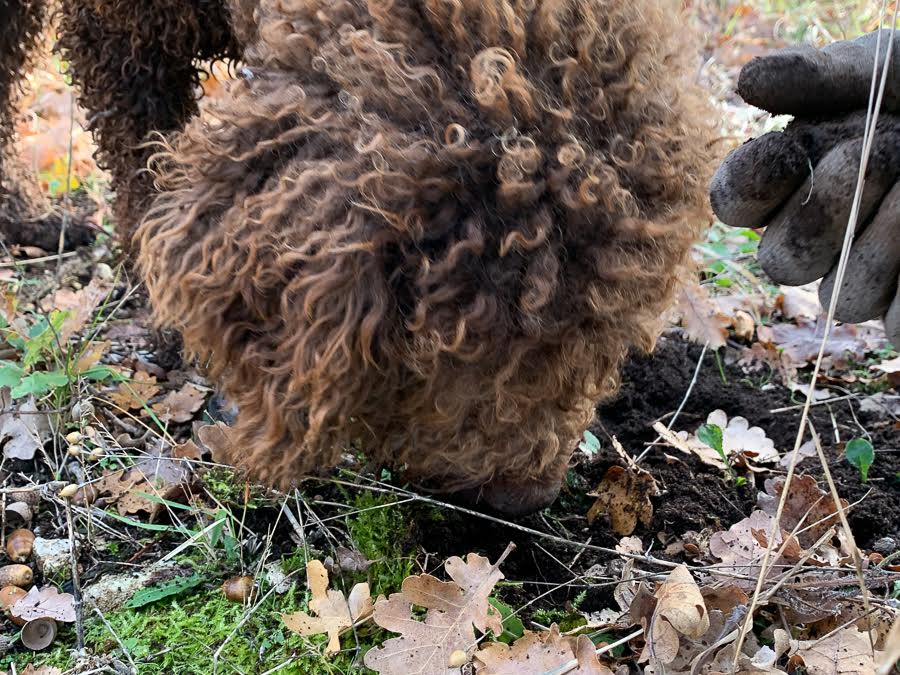
(One tactic in training dogs is to stuff toys with truffles and bury them, making a hide-and-seek game fun for them.)
When it was time to hunt the dogs were focused, moving from one spot to another as scents caught their attention. Aldi and Indi work together but they don’t dig in the same hole. When one finds a truffle spot the other one watches over his shoulder, as if waiting for the results. I don’t know if this is typical behavior for truffle dogs but it looked like team spirit, sort of like saying “hey buddy, nice score” and giving a high-five. Sometimes a dog would lay down right next to his spot while Tonci or Ivana dug into the soil to retrieve the prize.
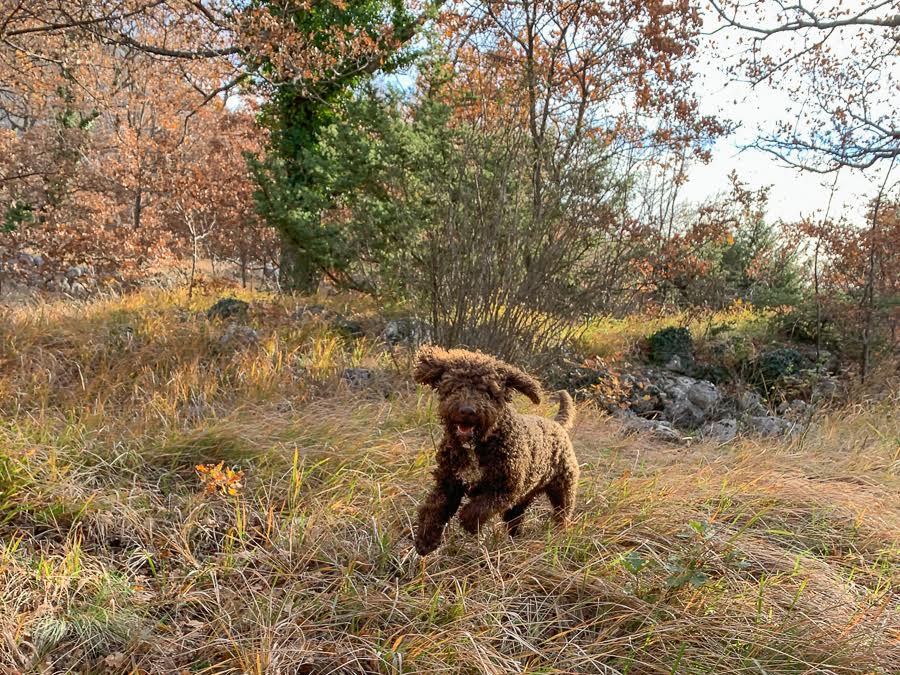
(Lagotto Romagnolos are the primary dogs specifically bred for truffle hunting. Truffle dogs can be expensive, it's not unheard of to pay $4,000 for a prime Lagotto and another $5,000 to train it. Training starts from two months of age and takes about two years for a dog to mature and become really good. They want to play, but they’re still working.)
Seductive smell
These trained animals were constantly moving and sniffing for good reason. As a truffle matures it releases a pungent odor when ripe, which is key to the hunting process. The smell comes from volatile organic compounds, similar to pheromones released by a male pig. I knew about truffle hunting with pigs and now I know the reason—they’re an aphrodisiac for a female. Pigs are natural hunters but also feeders, which is an abrupt way to watch your hard work and profit go down the drain; dogs are preferred.
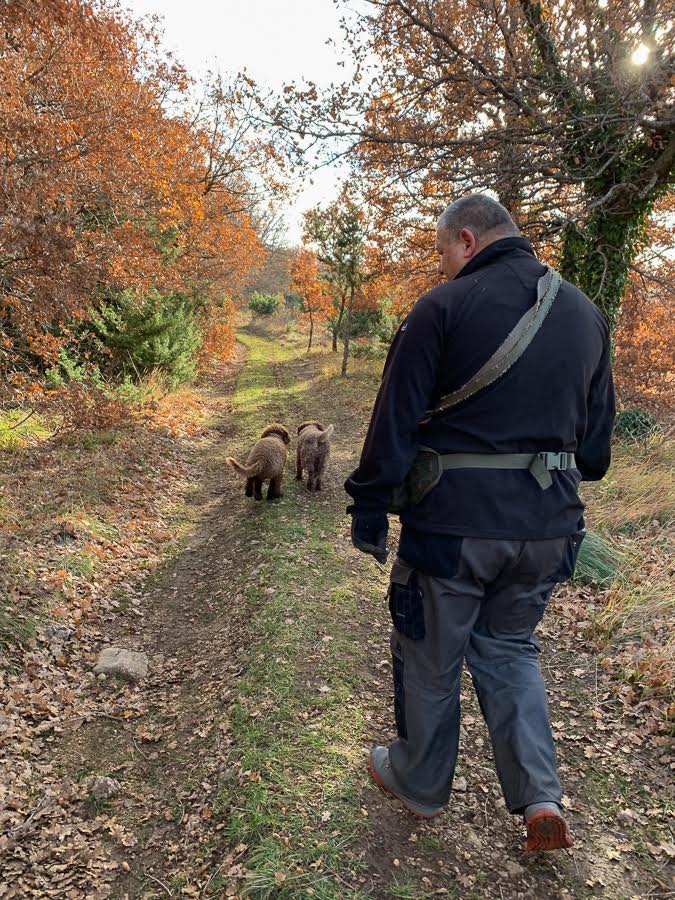
(Aldi and Indi are more than working dogs, they’re beloved family pets. They have their own room in the house with a carpet, a couch, and a television. What do they eat? Regular dog food.)
Intoxicating appeal
It turns out there’s more to truffles than sex appeal. Researchers in Italy found that black truffles produce a natural chemical compound similar to marijuana's active compound tetrahydrocannabinol (THC). Truffles are not chemically addictive but many people find them intoxicating. “You start to eat and you always want them,” says Ivana. “The dogs have the same reaction, it’s like a drug. Indi lays down on the hole because the smell makes him happy, and crazy.”
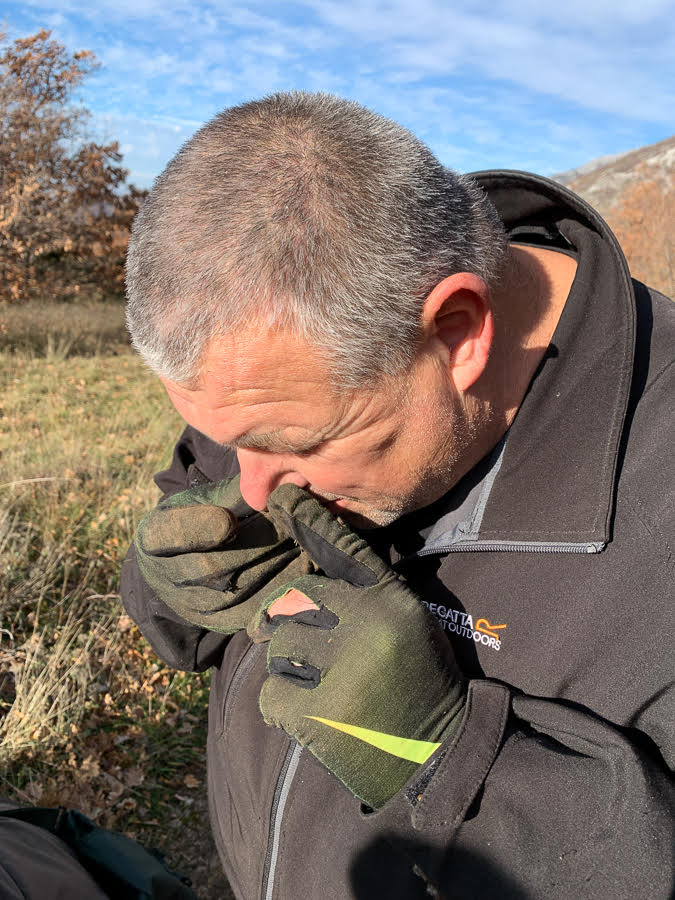
(A truffle’s size and smell are factored into their overall value, which can reach into tens of thousands of dollars at market.)
Nature Lover
How does someone get into this business anyway? It helps to be a nature lover and like most Croatians, Tonci Najev thrives on being outdoors. This is clear from his notable background as a professional diver. His feats include being on the expedition team that made the first-ever dive into the Red Lake, near Imotski, and earning records for descending 100+ meters (330+ feet) with pure oxygen, no mixing of gases in the tank.
In those days Tonci spent the mornings diving for sea coral and the afternoons hiking. Up in Split’s mountains, locals told him they’d found truffles. His interest was piqued and he began researching the land, the trees, and the dogs. Today, with perseverance and persistence, Tonci has discovered 100+ truffle locations and he holds the first and only truffle hunting business permit in Dalmatia.
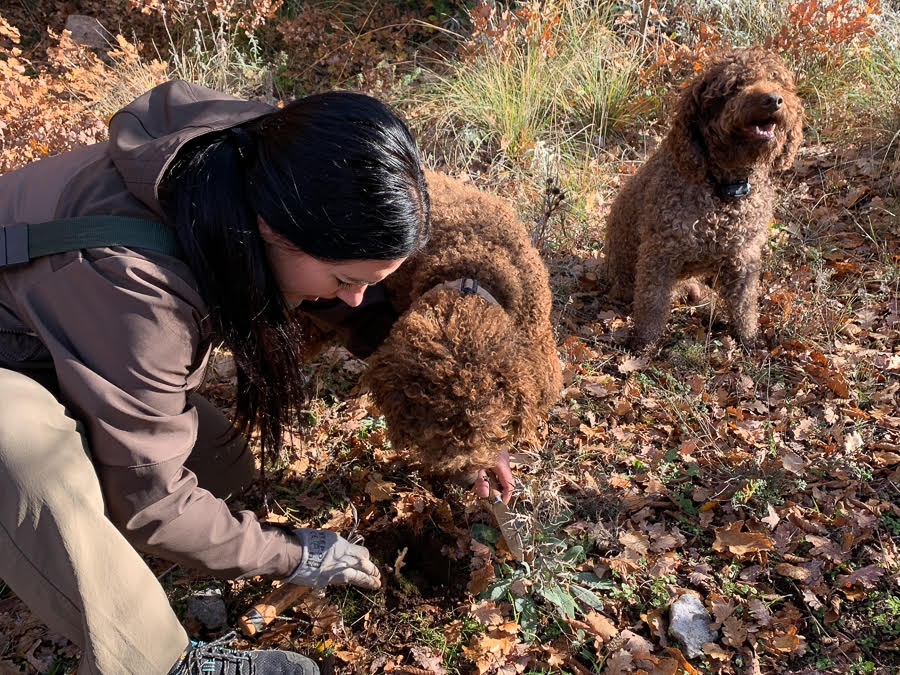
(People often ask if the dogs work just to get a reward. Ivana says Indi and Aldi are eager to please and to see their father (Tonci) happy.)
Black and white
Two main truffle species are among the most esteemed food products in the Mediterranean: Piedmont/Italian white truffles (tuber magnatum pico) and Périgord/French black truffles (tuber melanosporum). They are the first and second most expensive truffles in the world, respectively.
They grow wild in the forests of southern Europe and they’re native to France, Spain, Italy, Slovenia, and Croatia. Limited availability contributes to their value, as the majority of truffles on the market are cultivated.

(What do Aldi and Indi eat? Regular dog food.)
Exclusive and expensive
Given the secret growing locations, labor-intensive sourcing, specially trained animals, limited quantity, and a short lifespan, truffes are a delicacy in the same camp as other rare foods: saffron, caviar, kobe beef, Densuke watermelon, and fugu.
In 2020, white winter truffles (magnatum) sold in the range of $3,000-$4,000 USD per lb. (retail) and black winter truffles (melanosporum) sold for an average of $1,500 USD per lb. Prices constantly change and vary per the yields of the growing season, the class of truffles (including size and smell), and the rarity of the type. I found reports on European wild truffles selling at auction for hundreds of thousands of dollars. Damn. I’d love to know the life story of one of those mushrooms.

(Dalmatia’s oak trees and karst landscape make a special environment that’s ideal for wild truffles to grow.)
Dalmatian truffles
On Mosor, we found two types of black winter truffles: tuber melanosporum and tuber brumale. Yesss! We got the good ones! I was impressed that we found anything at all, the ground seems to favor rocks. It’s described as a karst landscape, one that’s made up of limestone and has some sort of a natural drainage system beneath. As it turns out, the terrain and Croatia’s climate make an ideal habitat for wild truffles.
One other thing is needed—the right tree. Truffles grow underground in symbiosis with certain trees; specifically, truffle spores and tree roots share nutrients. Dalmatia delivers on this too and some of the most common “truffle trees” grow here—Hrast (Oak), Grab (Hornbeam), Smrič (Spruce/shrub), Corylus Avellana (Hazel), and Populus Alba (Poplar).
Dobak Tek
After a successful morning hunting, it was time to eat. Our dining room was Mosor Mountain, under a large oak tree, appropriately. Once again, I enjoyed fresh truffle pasta—prepared right in front of me—while sipping local wine and gazing at Croatia’s beautiful scenery. A spread of cheese, meat, and soparnik was the second course, all of it topped with freshly shaved truffles. I was glad I had skipped breakfast.
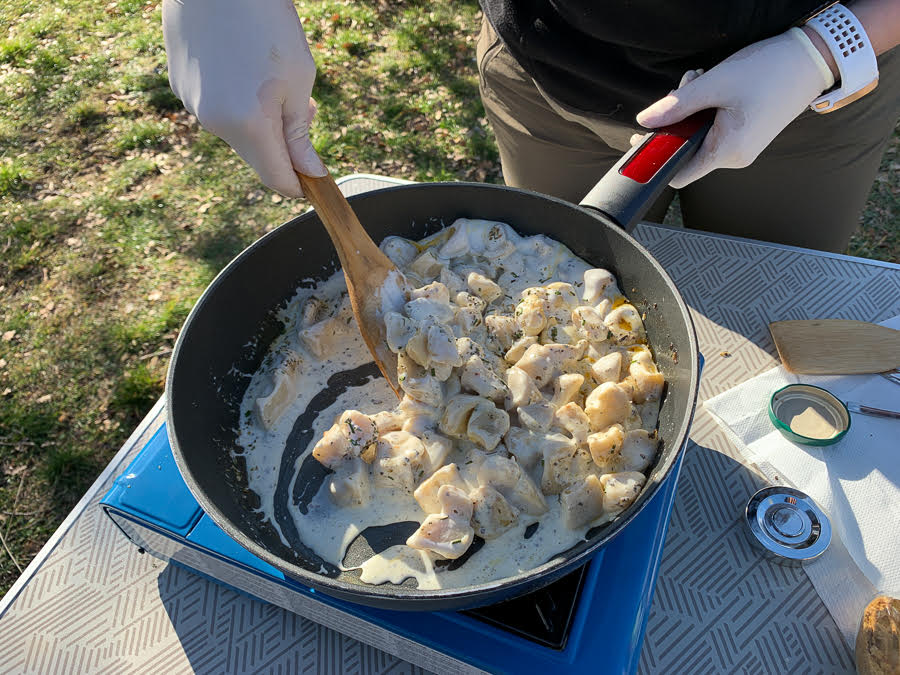
(The morning hunt culminates with a fresh meal of homemade truffle pasta. Once a truffle has been unearthed, its journey from ground to plate should be no longer than ten days.)
It’s funny, the pasta was delicious but I can’t describe the taste that truffles add. Ton
i said chocolate and strawberry but I’d go toward earthy and musky. My palate isn’t that refined but I know what I like and I craved more. I really think there’s something to that seductive, intoxicating aroma; it engulfs your senses and your brain like a potion. Maybe the mere anticipation of truffles is what drives behavior such as auction madness…
Winding down
After an upbeat morning I was pleasantly surprised that the tour kept going. On the drive back to our meeting location Ivana pointed out several places of cultural and historical importance—the remains of Skočiba, an old village in Gata that dates back to the Middle Ages; the church of Sveti Jure, on one of the highest mountain peaks in the country. It was a nice way to round things off and see more of Dalmatia’s heritage.
Leaving the seductive world of truffles, I thought about a modest comment Ivana made when we first discussed where to meet, “We do not have an office, nature is all we need.” I love that. I scored another great day outdoors, with good people and animals, in this country that I’m coming to appreciate more and more. By the way, there was no blindfold.
Learn more about tours with Truffle Hunting Dalmatia on the website.
Learn more at TCN’s Digital Nomads channel.
Story and photographs ©2020, Cyndie Burkhardt. https://photo-diaries.com
For more of Cyndie's experiences, check out her Croatia Through the Eyes of a Digital Nomad column.
Croatia Through the Eyes of a Digital Nomad: Giving Back While Gaining New Friends
December 9, 2020 - Cyndie Burkhardt continues her nomad lifestyle with her experiences in Croatia - this week the digital nomad giving back through volunteering.
Digital nomads, travelers, and expats are often passionate volunteers in their host countries. On International Volunteer Day, a group of people from different backgrounds and cultures came together to show some love to the Split community.
Passionate travelers strive to be immersed in the countries they visit by living and working with local people. For many of us, participating in positive impact initiatives is a favorite way to become more involved and to support causes we care about. Volunteers contribute all over the world, often to projects that would not exist without them. The rewards are considerable—help improve a community and bond with some pretty cool people in the process.
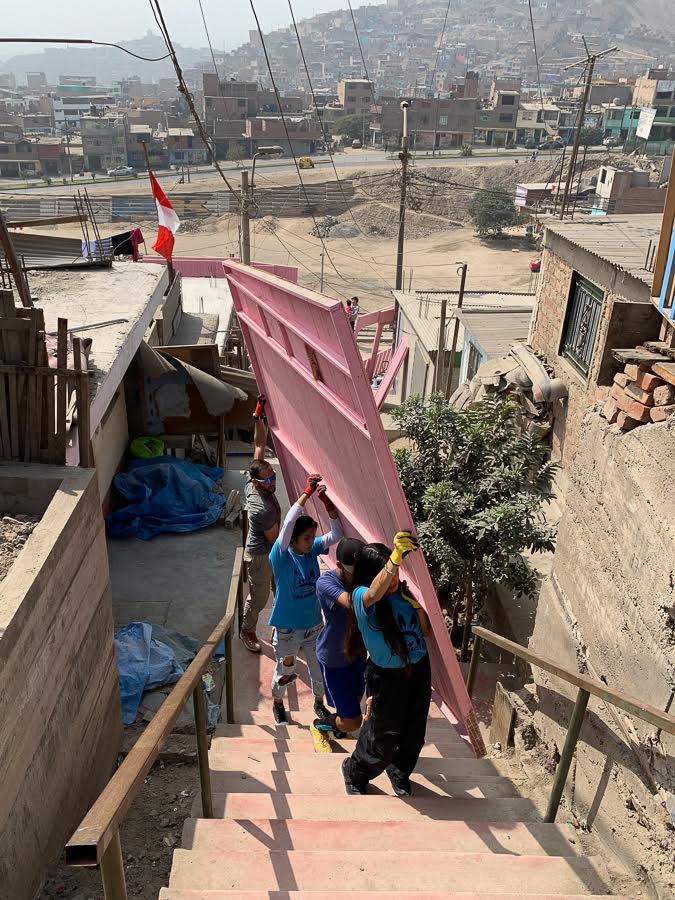
(Volunteers for Make a Miracle home building project near Lima, Peru carry all parts of a prefab house up multiple flights of steep steps to a site on the hillside where the house will be assembled. All hardware and tools follow the same pathway up. At the end of the day a family will have a safe place to live.)
Positive impact
People volunteer for a variety of reasons: to give back, help others, make a difference, feel involved, or use their skills in a productive way. For me, it’s each of these as much as being curious about culture and lifestyle. Volunteering gets you right in the middle of someone else’s reality. Some situations are feel-good and others are a dire wake-up call; all are opportunities to learn. Glimpsing a country through this sort of local experience is a chance to expand your perspective while becoming more conscious of your actions.

(Groups of friends, old and new, meet up to volunteer for the biggest reforestation project on Mosor Mountain, organized by The Scouts of Croatia Association.)
Safe housing
Last year I joined a home building project in Peru with a nonprofit whose mission is to “bring hope and lasting change” to poor neighborhoods, in part by ensuring that families with children live in safe homes. Scoping the dilapidated surroundings and the rundown shacks that people occupied, it looked like something out of a movie, for as far as my eyes could see. I tried to imagine living there, and worse, having no way out. My heart ached. Us volunteers worked side by side with the organizers, locals, and students. At the end of the day when the designated family was presented with its new home, there were tears, hugs, big smiles, and no better feeling than that of optimism. When you’re used to having a roof over your head you take it for granted. Being immersed in that environment and seeing the status quo of not having one really hit home for me.

(The Elephant Freedom Project is a camp in Thailand, near Chiang Mai, that rescues abused animals and allows visitors to learn about them and support their efforts. Baby elephants are there with their moms and they learn to interact with humans in a caring environment.)
Elephant freedom
Another time, in Thailand, I spent a day at an ethical elephant sanctuary—a camp that rescues and provides a better life for the animals—where I got to feed and bathe them in nature. Elephants are the beloved national animal and official symbol of Thailand and for that same reason they’re horribly abused in the name of profit. While feeding them, I watched the elephants inspect my hand and turn their trunks to just the right angle to grasp the food. It tickled when they took it. I swear there were moments when I looked in their eyes and I knew they were looking back at me. All day I witnessed, in awe, their sensitivity and intelligence. Of the many things I learned, nothing compared to my feeling of connection with these beings.

(Forestry rangers instruct volunteers on the proper way to plant new seedlings; the reforestation project goals are to plant over 30,000 new trees to replace those lost in the massive 2017 fire.)
Split causes
Here in Split, lots of organizations coax volunteers to support their cause. A recent meet-up was held to introduce a few of them, including animal rescue, a women's shelter, and environmental groups. Animal shelters are dangerous for me, I love dogs and I want to take them all home. But that didn’t stop me from spending time at NO KILL animal shelter Animalis Centrum. Hiking and being in the great outdoors are other passions of mine. I quickly said yes to volunteering for a reforestation project on Mosor Mountain organized by the Croatian Scouts Association. It feels good to circulate in the community and experience the camaraderie of real people doing real things. In other words—it’s time to get off the computer!
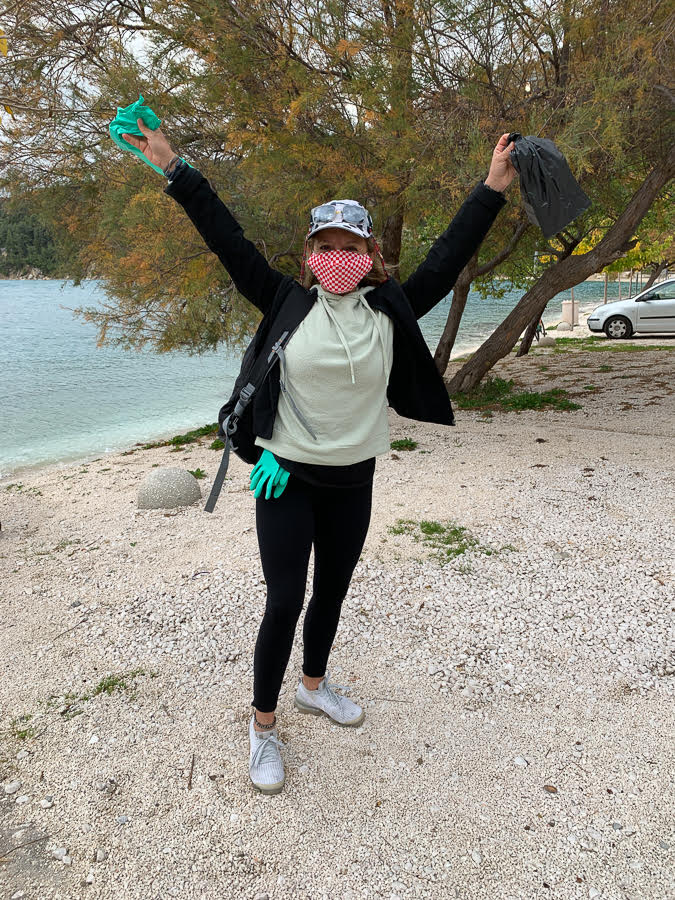
(Paola Palavecino is a spit ball of energy and she enthusiastically inspires her team to give their best effort and have fun.)
Beach cleaners
On International Volunteer Day, December 5, an independent crew led by Paola Palavecino descended on Kašjuni beach with trash bags, gloves, face masks, and determination to clean up the litter. For this lifelong beach kid, the assignment was a no-brainer. The seashore is my special place and it drives me mad to see trash discarded on the beach and washed up at the water’s edge. Who wants to lay their body down with that crap or swim through it? Given Croatia’s hunger for tourism, its heavy promotion of seaside/island pleasure, and its pride in the stunning natural landscape, immaculate beaches would be expected.
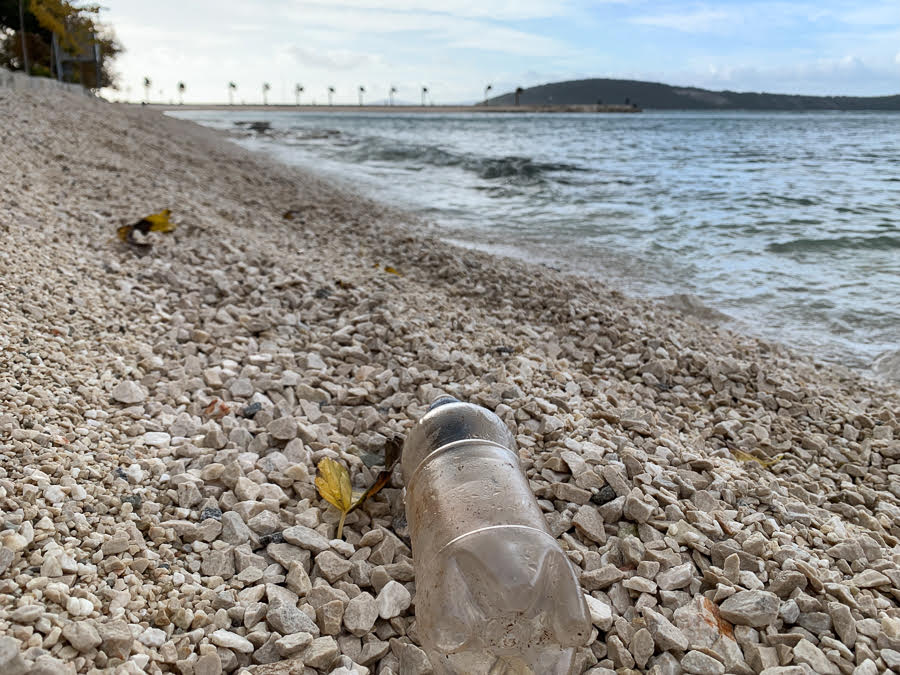
(Discarded plastics are a common sight on Split’s beaches and even isolated spots like Kašjuni beach can’t avoid them.)
It was the first dry day after a week of slamming rain and thankfully the storm clouds held off. In a matter of hours, we hauled construction waste, filled large garbage bags, and stuffed smaller bags with cigarette butts.
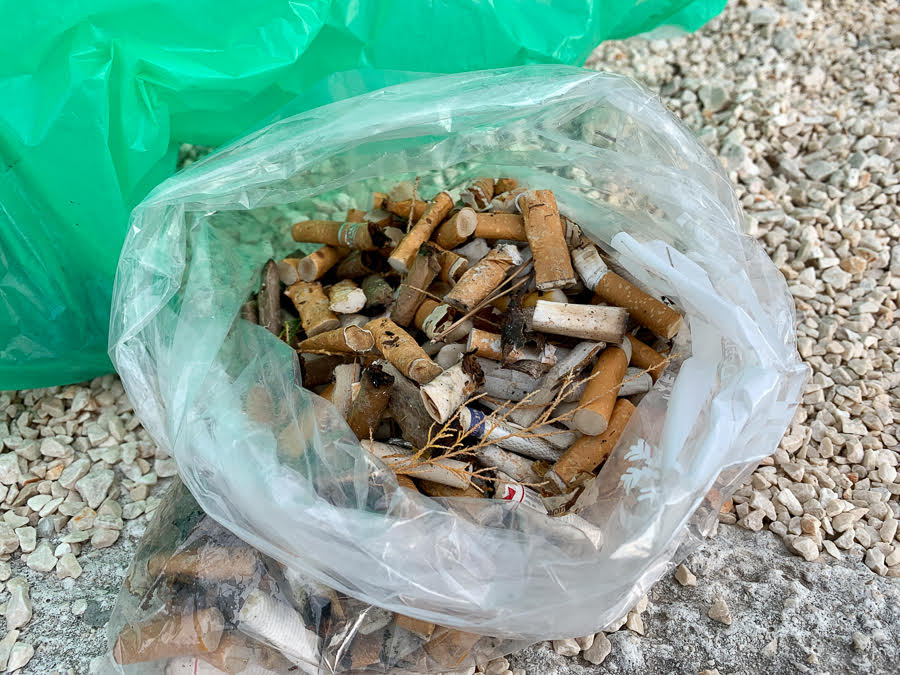
(Cigarette butts cause insidious harm through the release of heavy metals and other toxic chemicals. Statistics show that trillions of them are recklessly discarded, making them the world's most littered plastic pollution.)
Public Service Announcement
Pardon this interruption for a brief PSA: That last item may seem inconsequential because cancer sticks are so widespread here, but the facts are disturbing. Littered cigarette butts leach toxic chemicals—arsenic, lead, nicotine—into the environment and they can contaminate water. The toxic exposure can poison fish as well as animals that eat them. What remains is literally the world's most littered plastic pollution—trillions of those filtered tips are carelessly dumped into the environment annually. Whoa.
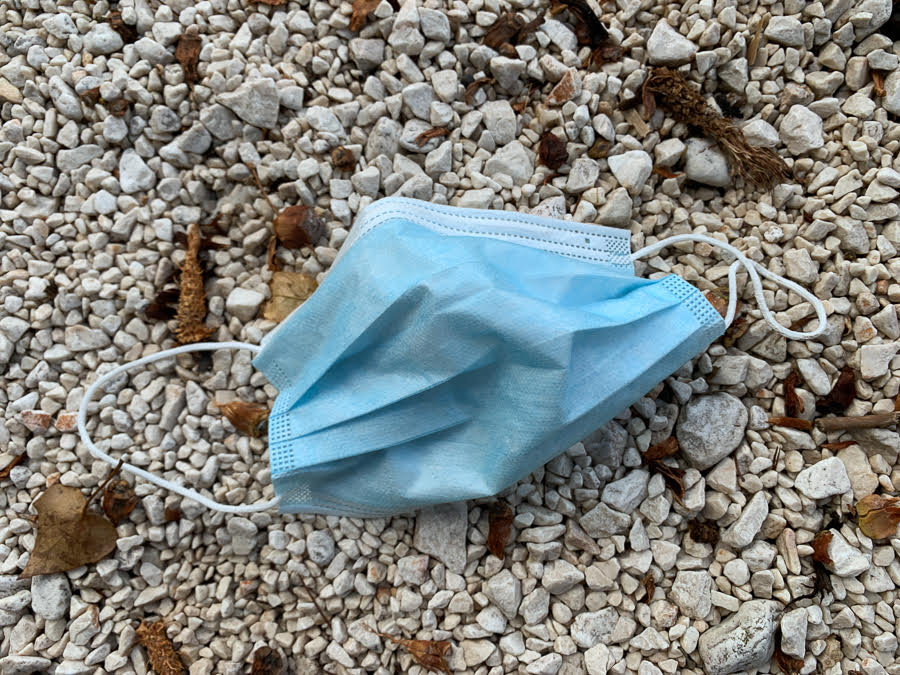
(A new garbage product is popping up everywhere, the protective face mask.)
People’s consciousness
While I was cleaning one particularly trash-ridden part of the beach, a local was watching me go back and forth. Eventually he asked what was happening and I explained our effort and who we were. He didn’t understand why foreigners cared about cleaning the beach but he was impressed nonetheless. Contemplating this and looking at my trash bags filling up he said, “I think this says something about the consciousness of the people.” I said I agreed and then he walked away before a conversation could ensue. Boy did I want to talk with him and ask some questions. Perhaps he felt embarrassed, or maybe guilty, about what that consciousness actually says.
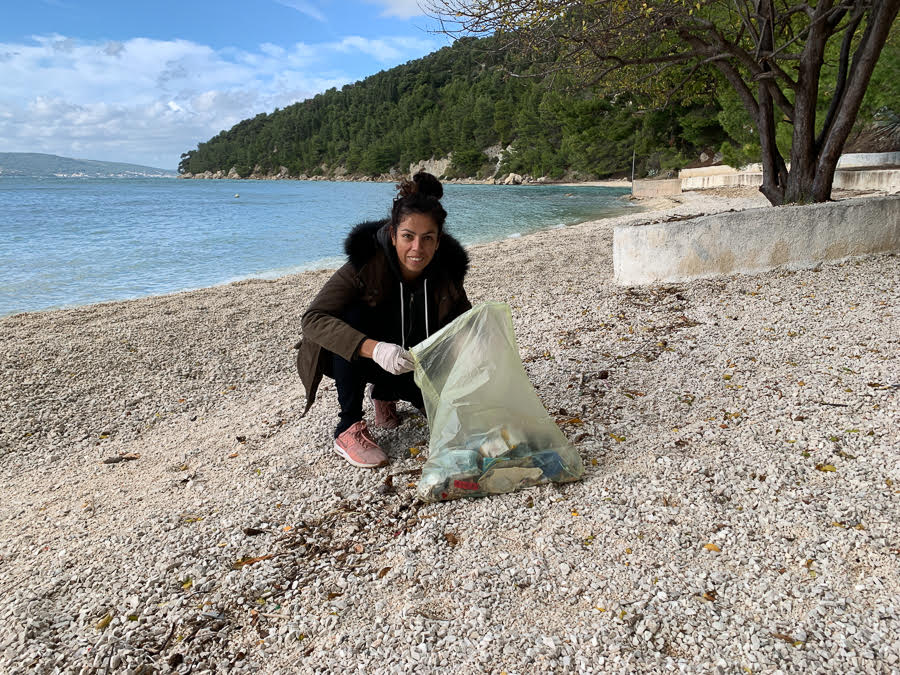
(Volunteer Roxana Jamett is no stranger to environmental projects and sustainability. With her blog Eco-Croatia.net she shows people what’s possible to reduce plastics and live in healthier, cleaner world).
Travelers’ mistress
Travelers do care, deeply. The world is our mistress and we gush with enthusiasm at every opportunity to engage with her. The benefits we reap through exposure to people and places and new possibilities are priceless.
In fact, the beach cleaning group was born from this mindset. An American traveler inquired on Facebook about cleaning Split’s beaches. Paola, a Chilean expat, read the post and recognized the need. Seeing that nothing was organized, she said “why not” and confidently rose up to lead it. The group that convened represented the additional countries of Australia, Croatia, Italy, and the UK.

(Picking up refuse is tedious and backbreaking, but the toxicity from cigarette butts and their damage to people and the environment is worse.)
International Volunteer Day
International Volunteer Day is a mandate of the United Nations General Assembly since 1985. It promotes volunteerism; recognizes volunteer contributions to local, national, and global communities; and celebrates all facets of volunteer impact. It was an honor and a source of pride to be with such a proactive group on a day that stands for caring and giving.
Top 5 Reasons
For anyone who’s curious about the joy of volunteering and hasn’t yet raised their hand, here are some things to consider.
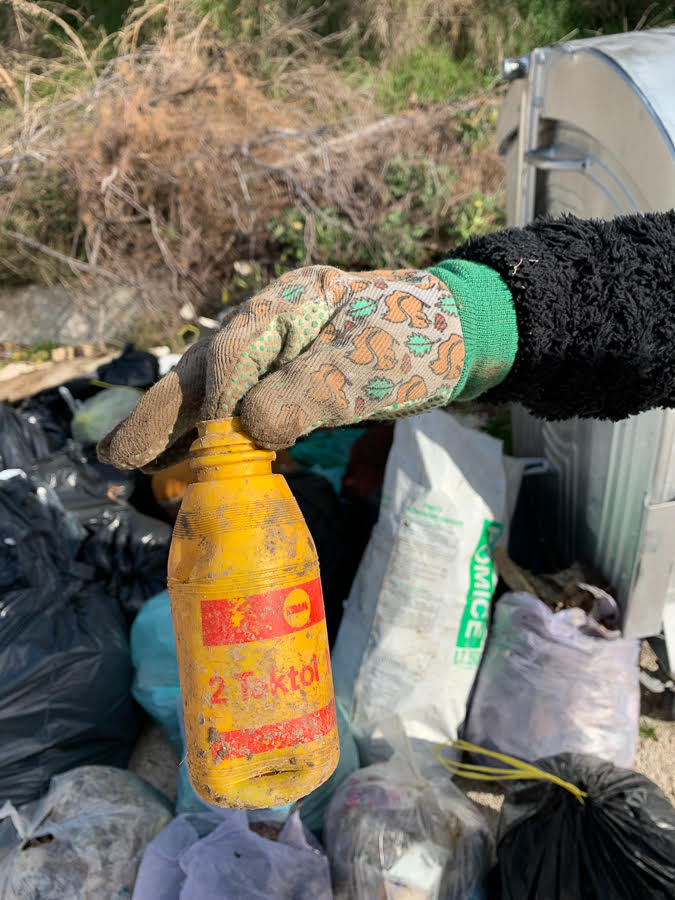
(The product 2 Taktol is motor oil and this particular plastic bottle, found on Kašjuni, is a design from last century, it’s over 20-years old.)
1. Volunteering abroad is an opportunity of a lifetime to make a difference in a particular region; experiences and memories will stay with you for the rest of your life. You will truly become a traveler and not just a tourist.
2. Volunteers gain new perspectives and often return home with a better understanding and appreciation for different cultures and people.
3. Meet new people and make friends for life with like-minded folks who face problems head-on and in doing so become part of the solution.
4. Contribute to something bigger than yourself and boost your career. People who volunteer abroad demonstrate innovation, creativity, selflessness, and willingness to “get their hands dirty.” Wouldn’t you want to hire or work with someone like that?
5. Give back by helping communities, environments, people, and animals who are endangered or unable to take care of themselves. It’s about realizing that we are all connected through a greater humanity.
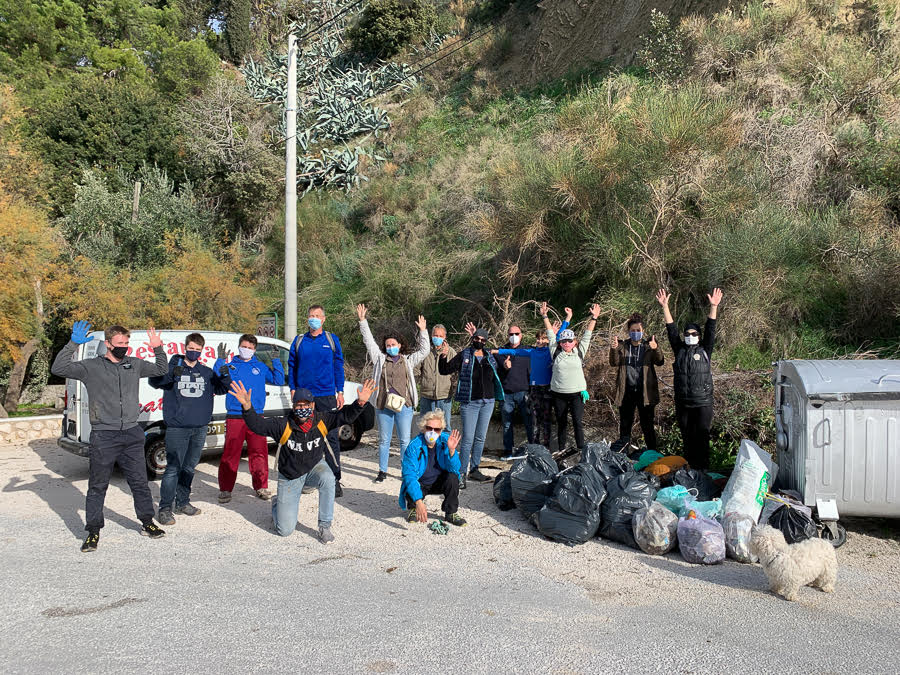
(The Kašjuni beach cleaning volunteers are proud of a strong effort to give back and help make a difference.)
Learn more at TCN’s Digital Nomads channel.
Story and photographs ©2020, Cyndie Burkhardt. https://photo-diaries.com
For more of Cyndie's experiences, check out her Croatia Through the Eyes of a Digital Nomad column.
Croatia Through the Eyes of a Digital Nomad: Croatia's Endless Summer Sport
November 26, 2020 - Continuing our look at the digital nomad lifestyle in Croatia, it may be late November for some, but Croatia's endless summer sport continues for some.
The Adriatic Sea is a focal point for seasonal visitors to the Dalmatian coast for good reason; it’s positively refreshing on hot summer days. But some people swim long after the crowds have gone, when the only onlookers are wearing coats.
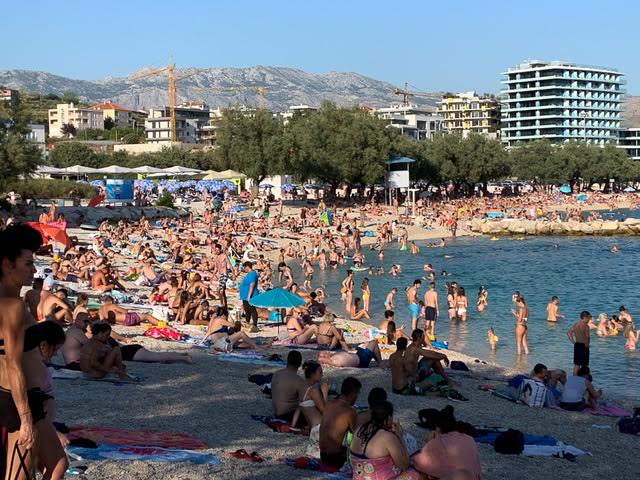
(When summer tourists crowd Split’s beaches, everyone carves out their own spot on the sand and in the water.)
Ever since I heard that Split’s summer weather can occasionally extend into fall, I got it in my head that I wanted to swim as late into the season as possible. Swimming is one of my favorite sports for the feeling of being in the water as much as the exercise. Everything about it signals freedom and expansion, increasing my movement, thoughts, and bodily sensations. I love the open water and Croatia’s total seaside environment—sun, salt, azure sea, temperature, and rugged beauty—is perfect.
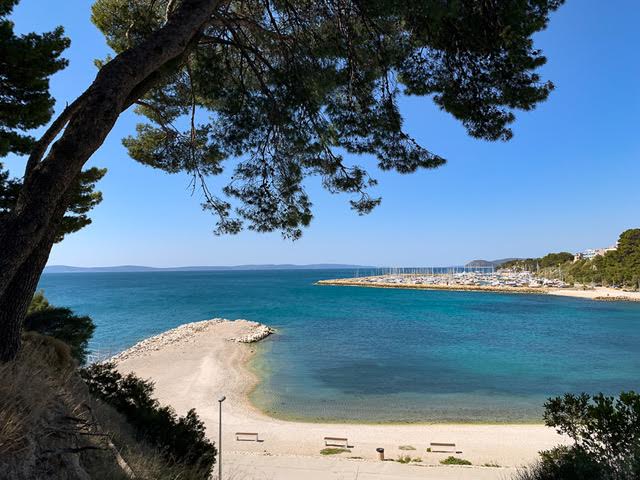
(Pine trees, white beaches, and teal waters are hallmarks of the Mediterranean coastline that draw visitors from around the world.)
Before tourists
Back in the spring, during early morning Žnjan beach walks, I’d end up sitting on a rock with my bare feet dangling in the water. Sure, it was cool outside, but I was bundled up in layers and my feel were thankful to be out of socks and shoes. As I looked over my surroundings, I craved summertime just to be fully immersed in the gorgeous water. When it finally arrived, I plotted my swims—whenever and wherever.
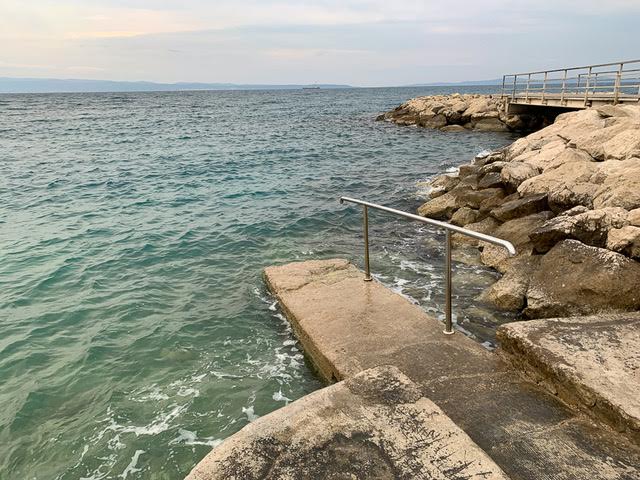
(Ramps and other accommodations are found all along the seaside; they allow people with disabilities to get into the water.)
Island life
A rocky enclave on Lokrum, the Blue Lagoon near Trogir, the famous Zlatni Rat on Brač, and diving off a sailboat were perfect staging grounds for my addiction. I was mindful to soak up every minute in these brilliant surroundings. Sometimes I’d pop my head above the surface and laugh at my good fortune and my happiness; it was pure joy.
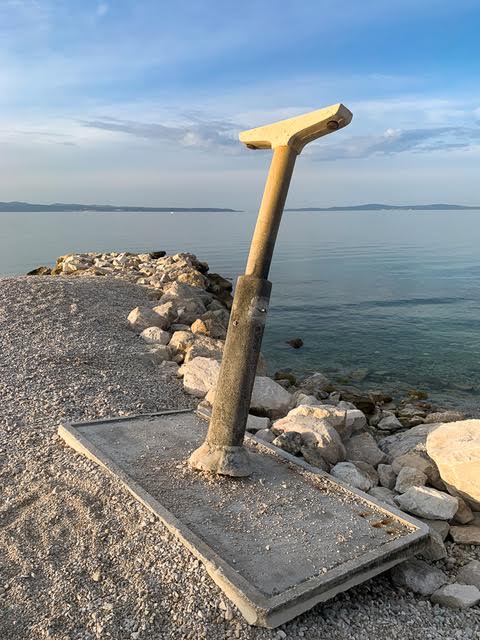
(Shower facilities on every beach look like aliens from another planet.)
Opportunities everywhere
It seems any spot to enter the water is fair game. Croatians will climb through large rocks and pull their cars to the side of the road just to take a dip. I learned to toss my bathing suit and travel towel in a bag when meeting friends because an opportunity could pop up any time. After visiting a bee farm on Šolta, I swam before coming home because why not try another island, right? When biking around Marjan Park, I pumped my brakes at the sight of Kašjuni beach and promptly turned back to join the bathers. Dalmatians inherently love the sea and for them, this behavior is second nature.

(View from just above the surface, where colors and textures from above and below the water meet.)
Ideal weather
September, October, now November… and I’m still checking the sea and air temperature daily. My bathing suit hangs on a doorknob as a visual reminder; each day I hope it’s the right one. So far quite a few have worked out, even though we’ve passed the Daylight Savings mark on the calendar. Back home my swim gear would’ve been packed away months ago. The Atlantic Ocean is not this agreeable.
Getting cooler
Let’s be real though, things are cooling down. On both ends of these late fall days I wear proper fall clothes. Yet, today the water and air temperature were nearly equal at 18.8ºC (65ºF) and I swam effortlessly. A small admission: I get cold very easily. The idea of swimming in November is way past my comfort zone and I honestly don’t know how I’m doing it.
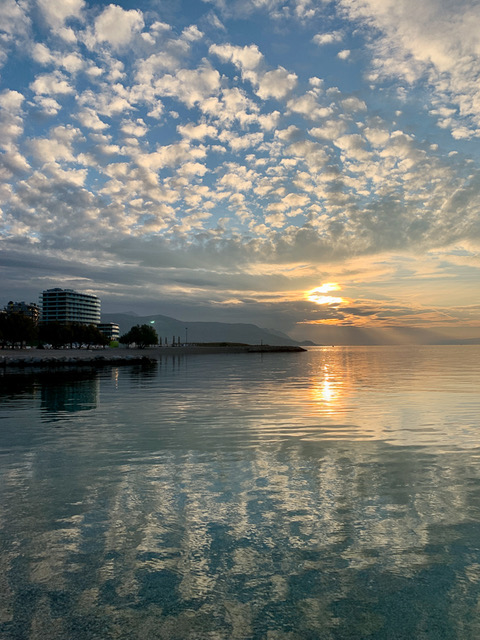
(The morning sky can create the best view for an early swim.)
Still swimming
Perhaps living in a new place brings new inspiration. Or maybe the cold is all in my head. I don’t need to figure it out, I’m still swimming and loving it.
Learn more at TCN’s Digital Nomads channel.
Story and photographs ©2020, Cyndie Burkhardt. www.photo-diaries.com/
For more of Cyndie's experiences, check out her Croatia Through the Eyes of a Digital Nomad column.
Croatia Through the Eyes of a Digital Nomad: Social Gathering Alert, also Known as Olive Picking
November 12, 2020 - Continuing our look at the digital nomad lifestyle in Croatia, the month of November means only one thing - to the fields for olive picking.
In the spirit of age-old Dalmatian tradition, many families offer a home-cooked meal (probably Peka) and plenty of vino in exchange for some manual labor in their olive grove.
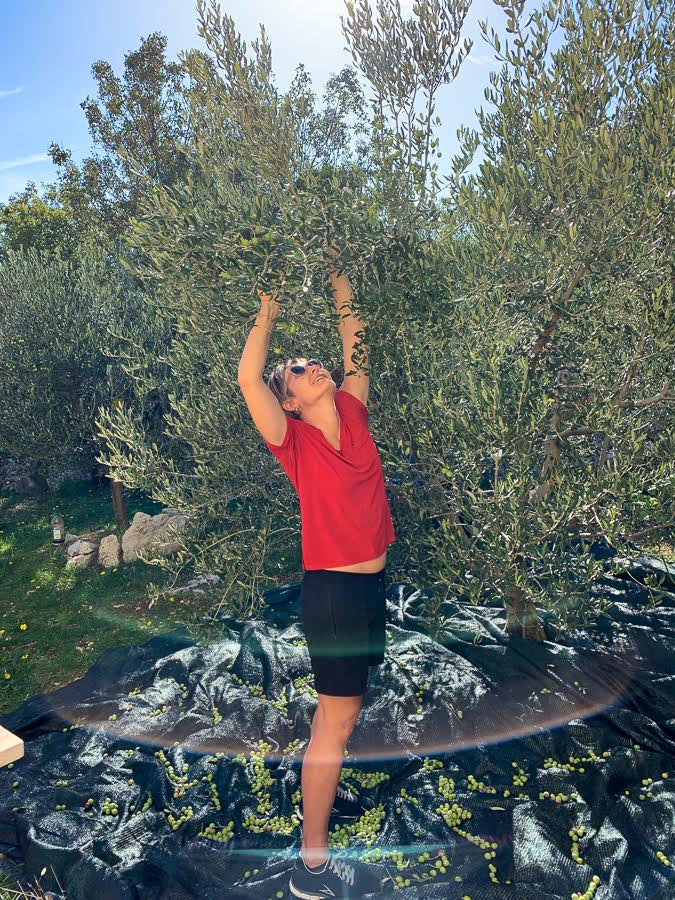
(Working beneath the tree, you have to be careful not to crush the fresh-picked olives on the ground near your feet.)
It’s pickin’ time! Growing up in New Jersey, I know a thing or two about harvesting, mostly the anticipation of delicious, fresh food right off the vine. The state’s motto, after all, is “The Garden State” and it harvests over 100 different types of fruits and vegetables. The official state food is the Jersey tomato. I don’t really like tomatoes but man, ours are super fresh, tender, and seriously good! And the little cherry tomatoes are downright addictive.
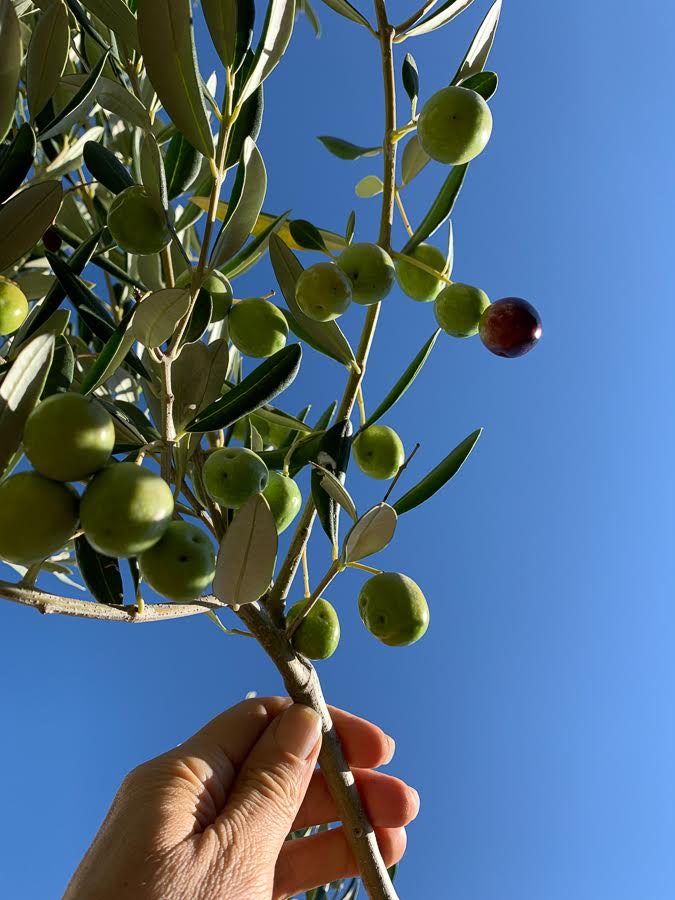
(Olive oil’s flavor depends on the color and ripeness of the olives when picked.)
Fond memories
Some of my fondest childhood memories involve picking fruit in the field with my family. My grandfather loved strawberries and come June we’d drive to the local pick-your-own farm. There’s nothing quite like getting your hands dirty in the strawberry patch on a sunny day and sneaking samples, one after another. Who could resist those juicy ripe jewels? Those were special times—talking, laughing, and gathering food we’d eat together. As soon as we got back home my mother pulled out her strawberry shortcake recipe and got to work. With the smell of shortcake baking in the oven, she’d gently mash the berries. When it was finally assembled, we all sat at the kitchen table and enjoyed a special homemade treat. Warm cake, like a sweet biscuit, layered and topped with a juicy berry mash was spectacular. Our vine-to-table experience lasted only a few hours, but it was some of the best bonding time a kid could wish for.
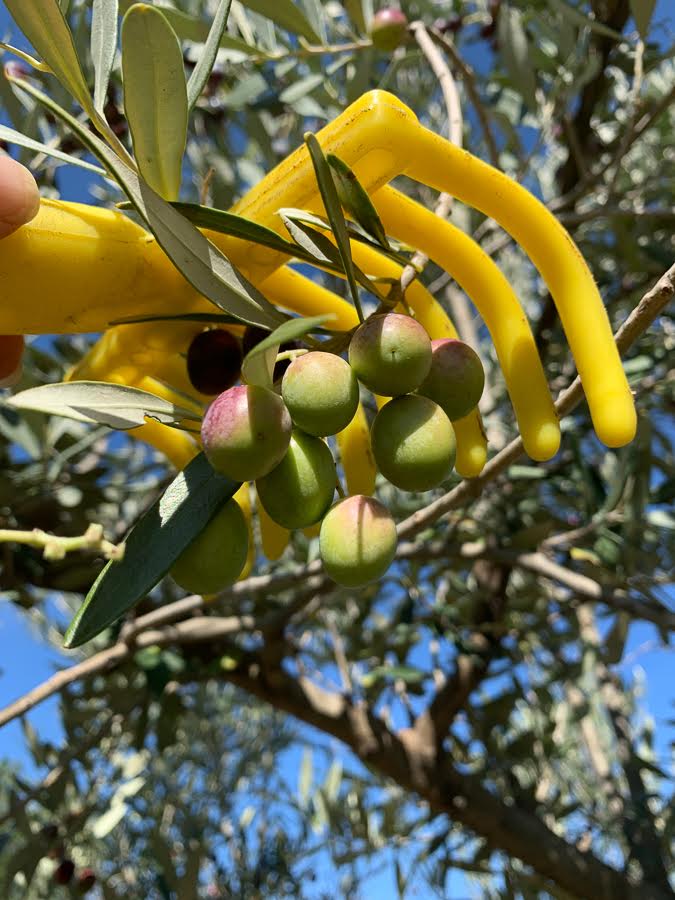
(A small hand rake is the only tool used on this family farm.)
Croatian harvest
A Croatian friend mentioned picking olives at her family grove and I jumped at the chance to help. Spending time with her and the family and enjoying a fun day outside had my name written all over it. I was also keen to experience this harvest tradition and learn more about Croatia’s olive oil—the liquid gold that’s key to Mediterranean cuisine.

(Placing tarps and gathering up the olives are other jobs on picking day.)
They picked me up in the morning and we drove to the family house in Trogir. Dad laid tarps around the base of the trees, like bibs, while Mom warned me about the sharp leaves. We started in the front yard and picked for several hours until lunch time. It was all done by hand, except for a small hand rake I used to reach the olives in the higher branches. Occasionally one of us would climb a tree and extend our bodies to the point of teetering just to get that patch of olives way up there. We shared stories and laughed.

(A fresh picked basket of olives, cleaned from stems and leaves, is ready to rest in a saltwater bath before going to the mill.)
In the background, slabs of beef were being grilled and green beans, potatoes, and other food was being prepared. By the time we sat down to eat, including plenty of local wine, we had conquered the front yard. Conversation around the table was filled with warmth and happiness.
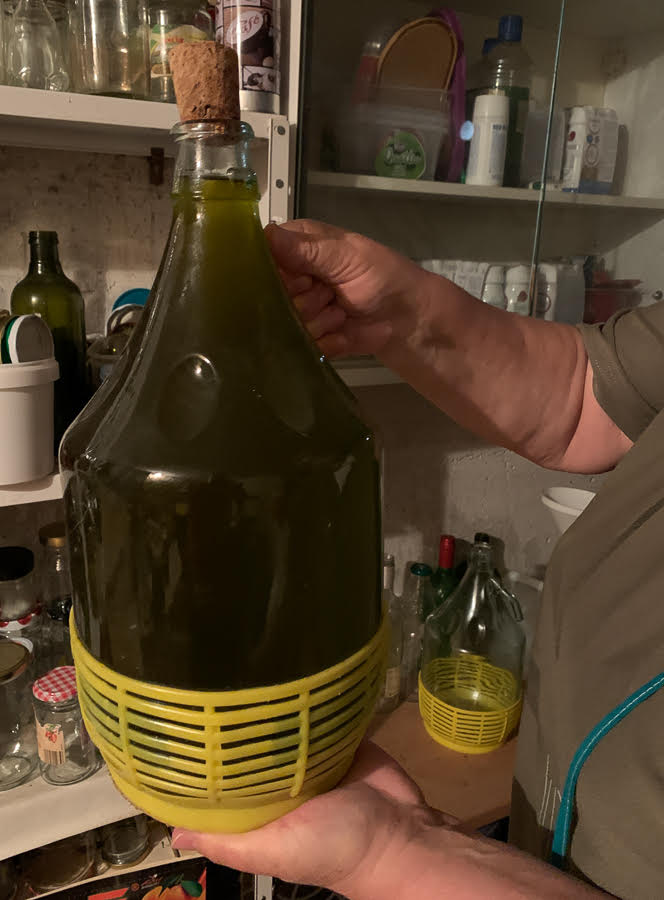
(Hand-crafted olive oil is typically stored in large bottles and kept in dark, dry places to retain freshness.)
With full bellies we went back to the field. I was eager to keep going and my goal was to finish as many trees as possible so the family would be ready for their appointment at the mill. Once you start harvesting the clock is ticking. You have to utilize the olives within three days of picking; if they sit any longer, they’ll oxidize and “sour.” We called it a day at 5pm, only because the sun was setting. We’d gotten through nearly half of the grove and glasses were raised to toast our strong effort.

(The olive tree is one of the heartiest trees on earth. It’s resistant to Croatia’s strong Bura and Jugo winds and temperature differences and it thrives in rocky terrain and salty atmosphere. An olive tree can live over one thousand years and occasionally bear fruit for centuries.)
Picking olive trees
Harvesting runs from August through November depending on the region, variety, and desired ripeness. All olives start out green and then gradually become rosy and finally black. Depending on the type of oil you’re making, a combination of all three may be used for pressing.
First, determine the flavor you desire. The earlier you harvest, the more bitter the taste. As olives mature, their flavor mellows. Larger olives have more oil but the content drops as the olives ripen. Green olives have a longer shelf life but tend to be bitter and take several months to mellow. If picking olives for oil, pick those with a light, yellow color. If picking olives to eat, pick green olives when they are mature but before they change color.

(An old stone mill at the Olive Oil Museum on Brač is a reminder of the hard, manual labor once used in production.)
The Olive Oil Museum
Earlier in the summer I learned about the history of olive oil production on the island of Brač at the Olive Oil Museum. Located in Škrip, the oldest village on Brač, this “oilery” was founded in 1864 and it processed olive oil for 100 years. In 1963 the mill closed shop when new technologies were introduced, namely the hydraulic press. It simply couldn’t keep up with modernization—the yields or the cost of new machinery.
The museum features the original old stone mill, a wooden spindle for pressing, and plenty of traditional tools decorating every inch of the walls and the ceiling, including funny looking goat skin bags that were historically used to transport the oil. Donkeys were strategic partners throughout the fully manual process and it’s an understatement to call olive oil production labor-intensive. To underscore the point, consider that you need 18 pounds of olives to yield one pound of oil.
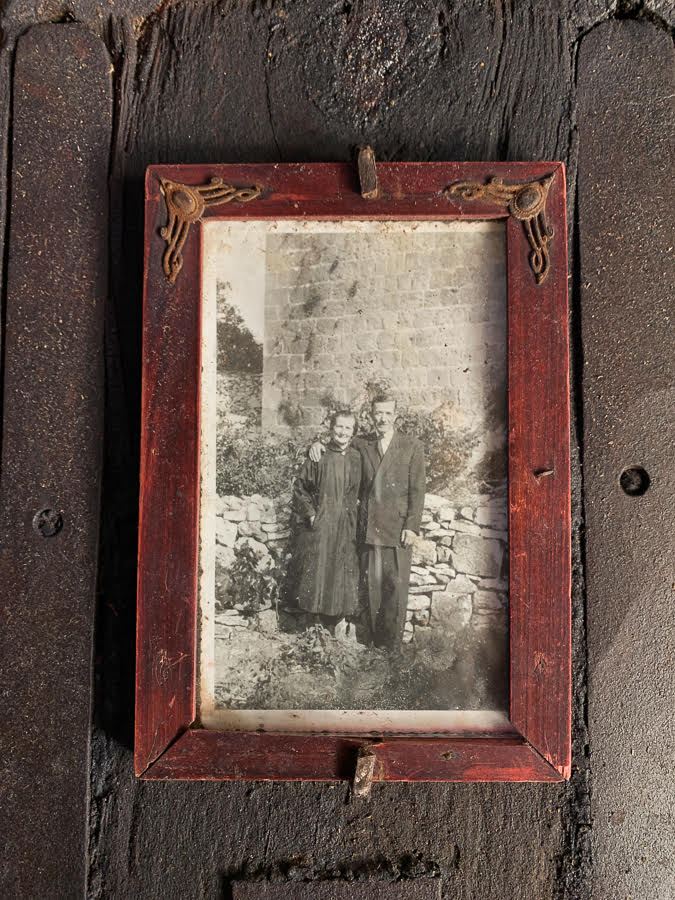
(A family photo from the early 19th century is affixed to the old stone mill in homage to generations of the family business.)
A very brief history of olive oil
Greece is credited as the first place to produce olive oil, around 2500 BCE when it was used as lamp fuel and in religious ceremonies in the Mediterranean. The oil appeared in cooking sometime during the 4th century BCE and in the Middle Ages, olive oil became an ingredient in soap and beauty treatments in Spain and France.
After all those centuries, it wasn’t until the 1960s that flavor became important. The introduction of the refined press transformed olive oil’s commodity status from a frying and cooking product into a delicious kitchen staple. Today we know it as a higher-end oil and a specialty good revered for its health and nutrition benefits.
In the 1990s, the International Olive Oil Council promoted olive oil as a key ingredient in the Mediterranean diet. In 2013, the Mediterranean diet was selected for the UNESCO List of the Intangible Cultural Heritage of Humanity. Interestingly, only seven countries endorsed the nomination and Croatia was one of them.
Taste
So how do you know what’s good? Place a taste of oil, not too much, under your tongue and inhale five or six times through your mouth. You should get a slight grassy taste and a pepperiness at the back of your mouth. Do you taste figs, lemons, or something fruity? If so, it’s fresh. The way to judge olive oil is on smell and taste, not color.
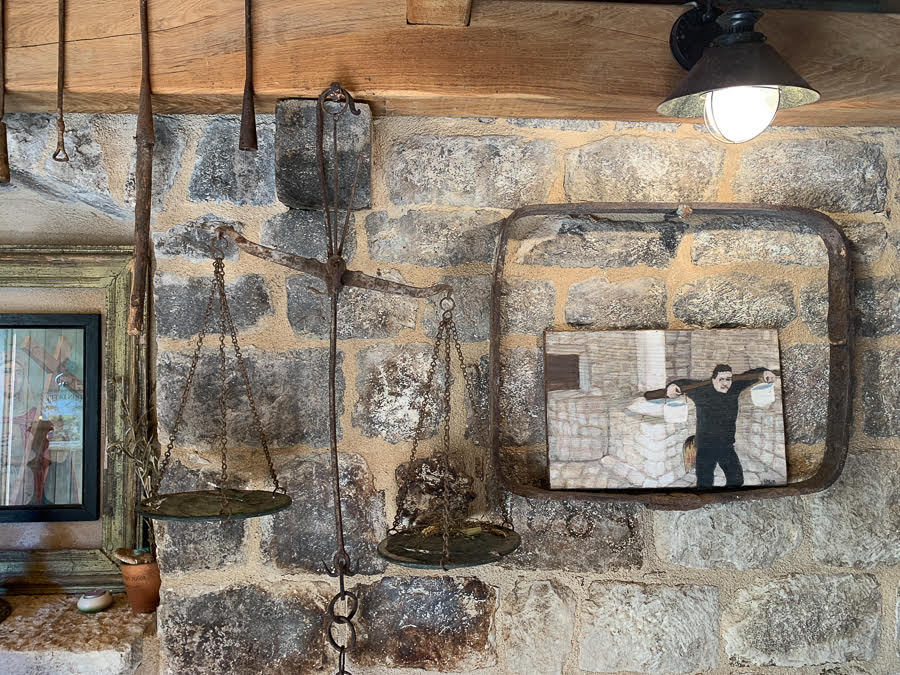
(The Olive Oil Museum displays paintings by academic painter Hana-Marta Jurčević Bulić that depict an earlier harvesting lifestyle.)
A superior product stays in Croatia
I’ve asked why, with so many trees and a superior quality product, Croatia doesn’t export its olive oil? One answer is that small batches are too much work and can’t bring a good enough return. The vast majority of Croatian producers are small farmers producing enough oil for their families and maybe some gifts. Another answer is probably closer to the truth—property here is chopped up so small that there’s no real opportunity for anyone to go big. I was told that in fact, Croatia imports olive oil to keep up with demand. That’s crazy.
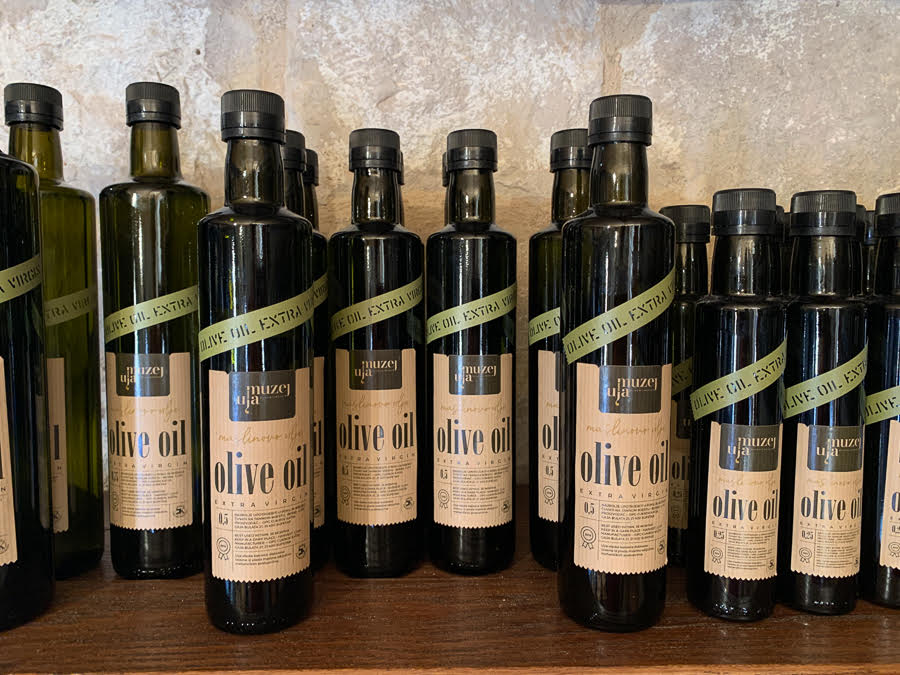
(Olive oil is a core component of the Mediterranean diet and it’s highly valued for its beneficial health qualities. The two most popular types are extra virgin olive oil (EVOO) and ordinary virgin olive oil.)
Nobody gets paid
There’s a lot to be said for Dalmatia’s cultural heritage and olive oil is a centuries-old foundation of life. The history of olive oil shows that people work hard to maintain their traditions as part of their ethnic identity and more recently to support their health and well-being.
Although modern machines and processes have galvanized the olive oil business at large, most Croatians are local farmers for whom the production of oil is a labor of love. It brings feelings of bonhomie and vitality. The reward is the joy of being in nature and a part of the magnificent countryside, having some fun, and sharing a lovely bonding experience with friends and family.
Learn more at TCN’s Digital Nomads channel.
Story and photographs ©2020, Cyndie Burkhardt. www.photo-diaries.com/
For more of Cyndie's experiences, check out her Croatia Through the Eyes of a Digital Nomad column.


